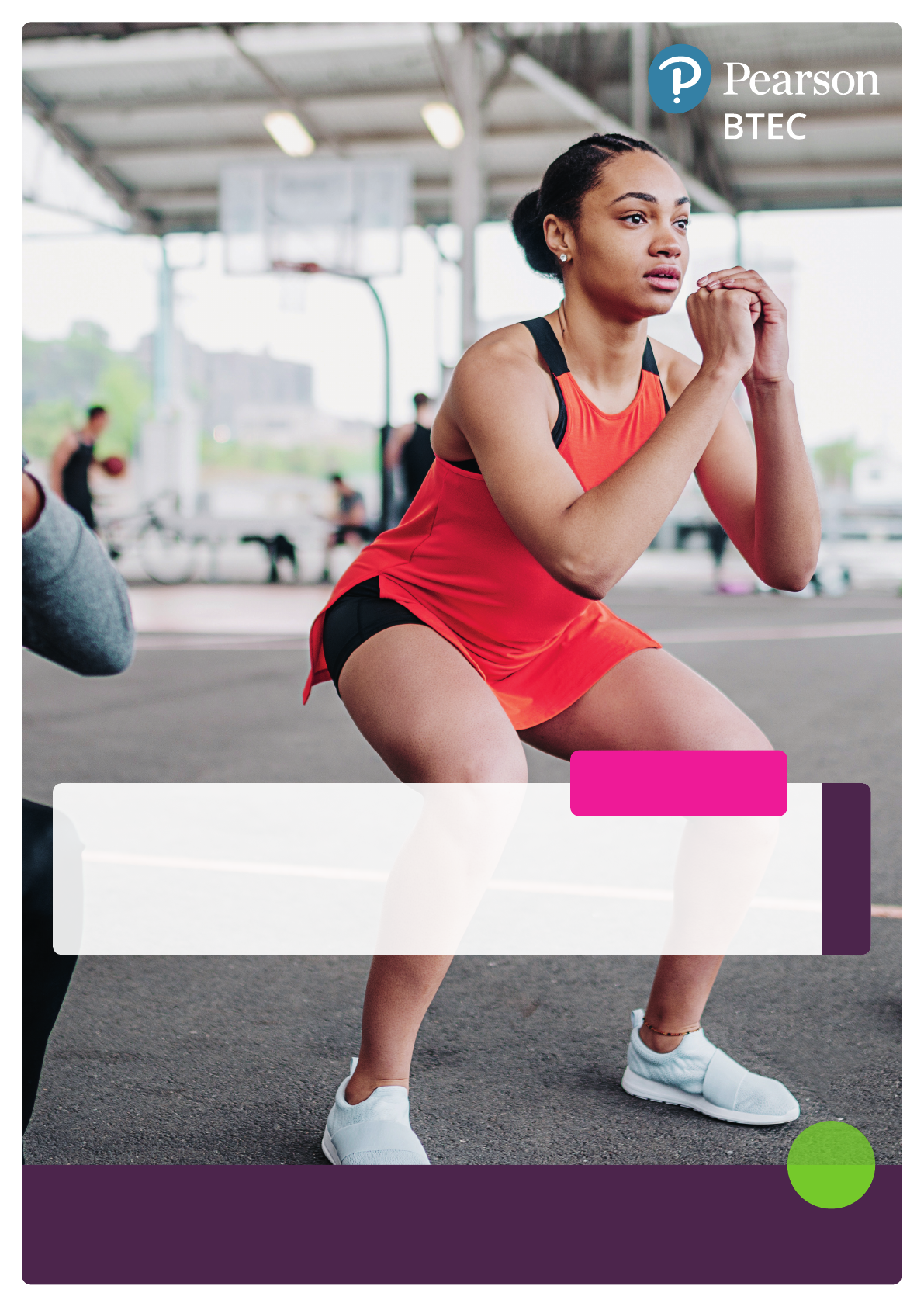
Pearson BTEC
Tech Award Level 1/2 in
Sport
Specication
Qualication No: 603/7068/3 First teaching from September 2022
Issue 3
First teaching from
September 2022
L1/2

Pearson
BTEC Level 1/Level 2
Tech Award in Sport
Specification
Qualification number: 603/7068/3
First teaching September 2022
Issue 3
About Pearson
We are the world’s leading learning company operating in countries all around the world.
We provide content, assessment and digital services to schools, colleges and universities,
as well as professional and vocational education to learners to help increase their skills
and lifelong employability prospects. We believe that wherever learning flourishes so
do people.
This specification is Issue 3. We will inform centres of any changes to this issue.
The latest issue can be found on our website.
References to third-party material made in this specification are made in good faith. We do
not endorse, approve or accept responsibility for the content of materials, which may be
subject to change, or any opinions expressed therein. (Material may include textbooks,
journals, magazines and other publications and websites.)
Publication code VQ000078
All the material in this publication is copyright
© Pearson Education Limited 2023

BTEC LEVEL 1/LEVEL 2 TECH AWARD
Pearson BTEC Tech Awards – introduction
About the BTEC Tech Award suite
Tech Awards have been developed by Pearson to give learners at Key Stage 4 in England,
Northern Ireland and Wales the opportunity to study one or more vocational areas as
part of their curriculum. We have developed the qualifications in consultation with
secondary school and further education representatives, and subject specialists to
ensure that they engage and prepare learners for either academic or vocational
progression post-16.
As part of a Key Stage 4 programme, learners will be studying a broad range of GCSEs,
including English, mathematics and science. The BTEC Tech Award suite has been
designed to allow learners to draw on the knowledge and skills acquired from these
subjects where relevant. When studying for a ‘BTEC’, learners can use the knowledge
and skills from GCSEs, giving them the opportunity to apply their academic knowledge
to everyday and work contexts.
The BTEC Tech Award suite is an introduction to vocational learning. The qualifications
give learners the opportunity to build applied knowledge and skills that show an
aptitude for further learning, both in the sector and more widely. The approach to the
suite is based on well-established BTEC assessment approaches that are proven to be
successful in building applied knowledge and skills and motivating learners to engage
fully with challenging study. There are many progression options as the skills acquired
are applicable to a range of post-16 study options.
The BTEC Tech Award suite differs from other BTECs designed to be taken post-16 as
the qualifications offer a basis for further study, rather than meeting all the vocational
requirements that learners need to progress directly to a job role in a defined
occupational area. The focus is on building applied knowledge and skills to show
aptitude and improving understanding of progression options so that learners who
achieve one or more of the qualifications are equipped to go on to become work ready
for an occupation post-16.
About recognition as Department for Education technical awards
The BTEC Tech Award suite has been designed to meet the Department for Education
(DfE) requirements for qualifications to be offered as technical awards for
14–16-year-olds.
The DfE has set out characteristics for technical awards through which vocational
qualifications can be recognised as part of performance measures in the open category
of Progress 8. To be recognised as technical awards, it is expected that qualifications will
focus on developing sector-specific applied knowledge and practical skills through
realistic vocational contexts. It is also expected that the qualifications form part of a Key
Stage 4 learning programme that enables both academic and vocational progression.

BTEC LEVEL 1/LEVEL 2 TECH AWARD
About the Sport sector
Year on year, the sport industry shows continued growth in employment and
forecasts suggest this trend will continue. This comes from increased knowledge and
understanding of the benefits of regular participation in sport and physical activity.
Sport England provides well documented research of these benefits including
improvements in physical and mental wellbeing, economic development, individual
development and social and community development (2020). These contribute
significantly to the quality of a person's life and, as such, there is a need to ensure
there are sufficient people working in the industry to meet this demand and encourage
regular participation in sport and physical activity. There has never been a better time
to study sport.
Study of this sector at Key Stage 4 will complement GCSE study through providing an
opportunity for practical application alongside conceptual study. There are also strong
opportunities for post-16 progression in this vital sector.

BTEC LEVEL 1/LEVEL 2 TECH AWARD
Summary of Pearson BTEC Level 1/Level 2 Tech Award in Sport
Issue 3 Specification changes
Summary of changes made between the previous issue and this
current issue
Page
number
Section 3: third paragraph, ‘internal verifiers’ has been changed to
‘Programme Leads’ and responsibility for the programme has been
separated between delivery and quality assurance.
Page 7
Component 1: Preparing Participants to Take Part in Sport and Physical
Activity
Introduction – second and third paragraphs, ‘physical’ has been added
before ‘activities’.
Learning outcome A: Explore types and provision of sport and physical
activities for different types of participant: introductory paragraph,
third line ‘sport or physical activities’ amended to ‘sport and physical
activities’.
Pages 9, 10,
14, 16, 17
We have amended the release dates for the Pearson-set assignments. Page 17, 32
Component 2: Taking Part and Improving Participants Sporting
Performance Marking grid for Task 4 (written) stem all bands, ‘planning
a drills’ amended to ‘planning drills’.
Page 36
Component 3: Developing fitness to improve other participants’
performance in sport and physical activity
D1: Personal information to aid training fitness programme amended
to ‘Personal information to aid fitness training programme’
Page 47
Section 5:
Internal Standardisation, guidance on retention of evidence of internal
standardisation activities has been clarified.
Moderation, guidance on the purpose of moderation has been clarified
and the requirement for evidence of internal standardisation has been
removed.
Pages 56, 57

BTEC LEVEL 1/LEVEL 2 TECH AWARD
Summary of Pearson BTEC Level 1/Level 2 Tech Award in Sport
Issue 2 Specification changes
Summary of changes made between Issue 1 and Issue 2
Page
number
In Component 3: Developing Fitness to Improve Other Participants
Performance in Sport and Physical Activity the table under Key terms
typically used in assessment section has been amended to remove Key
words/Command verbs that will not be used in assessments and the
definitions have been corrected to be in line with the Sample
Assessment Materials.
Page 49
In Section 5 Non-exam internal assessment under Marking Pearson-set
Assignments a new sentence was added regarding the Assessment
Record Sheet. Under Internal standardisation a new sentence was
added stating that Pearson will supply standardisation materials.
Pages 53, 55
In Section 5 Non-exam internal assessment under Moderation a new
paragraph has been added regarding learner sample and video
evidence.
Page 56
In Section 10 Resources and support under Training and support from
Pearson a new bullet point was added to state that Pearson Quality
Advisors can support with all quality assurance related aspects of
the programme.
Page 71

BTEC LEVEL 1/LEVEL 2 TECH AWARD
Contents
1 Pearson BTEC Level 1/Level 2 Tech Award in Sport – purpose 1
Who is the qualification for? 1
What does the qualification cover? 1
What can the qualification lead to? 1
2 Structure 3
Total Qualification Time 3
Components 3
Assessment 4
Language of assessment 6
Grading of the qualification 6
3 Components 7
Understanding your components 7
Component 1: Preparing Participants to Take Part in Sport and Physical Activity 9
Component 2: Taking Part and Improving Other Participants Sporting Performance 25
Component 3: Developing Fitness to Improve Other Participants Performance in
Sport and Physical Activity 39
4 Planning your programme 51
Is there a learner entry requirement? 51
What level of sector knowledge is needed to teach this qualification? 51
What resources are required to deliver this qualification? 51
How does this qualification contribute to Key Stage 4 learning? 51
What makes good vocational teaching? 51
5 Non-exam internal assessment 52
Pearson-set Assignments 52
Sample Pearson-set Assignments for internal components 53
Marking Pearson-set Assignments 53
Internal standardisation 55
Moderation 56
6 Quality assurance 57
Centre and qualification approval 57
Continuing quality assurance 57

BTEC LEVEL 1/LEVEL 2 TECH AWARD
7 External assessment 59
Role of external assessment for the BTEC Tech Award suite 59
External assessment 59
Timing of external assessment 59
Sample assessment materials 59
Conduct of external assessment 60
Pearson marking 60
8 Final grading and awarding 61
Awarding and reporting for the qualification 61
Eligibility for an award 61
Calculation of the qualification grade 62
9 Administrative arrangements 64
Introduction 64
Learner registration and entry 64
Access to assessment 64
Administrative arrangements for internal assessment 65
Administrative arrangements for external assessment 66
Dealing with malpractice in assessment 67
Certification and results 69
Results issue 69
Post-assessment services 69
Additional documents to support centre administration 69
10 Resources and support 70
Support for setting up your course and preparing to teach 70
Support for teaching and learning 70
Support for assessment 70
Training and support from Pearson 71
Appendix 1 73
Glossary of terms used for internally-assessed components 73

Pearson BTEC Level 1/Level 2 Tech Award in Sport – Specification –
Issue 3 – March 2023 © Pearson Education Limited 2023
1
BTEC LEVEL 1/LEVEL 2 TECH AWARD
1 Pearson BTEC Level 1/Level 2 Tech Award in
Sport – purpose
Who is the qualification for?
The Pearson BTEC Level 1/Level 2 Tech Award in Sport (603/7068/3) is for learners who
want to acquire sector-specific applied knowledge and skills through vocational contexts
by exploring the different types and providers of sport and physical activity and the
equipment and technology available for participation as part of their Key Stage 4
learning. They will also explore the different types of participant and their needs in
order to gain an understanding of how to increase participation for others in sport and
physical activity and further develop their knowledge and understanding of anatomy and
physiology. Learners will undertake practical sessions to develop skills in planning and
delivering sports activity sessions to participants. The qualification enables learners to
develop their sector-specific skills, such as sport analysis and sports leadership, using
realistic vocational contexts, and personal skills, such as communication, planning, time
management and teamwork through a practical and skills-based approach to learning
and assessment. The qualification recognises the value of learning skills, knowledge and
vocational attributes to complement GCSEs. The qualification will broaden learners’
experience and understanding of the varied progression options available to them.
What does the qualification cover?
The Tech Award gives learners the opportunity to develop sector-specific applied
knowledge and skills through realistic vocational contexts. Learners will have the
opportunity to develop applied knowledge and skills in the following areas:
● investigating provisions for sport including equipment and facilities to enhance
sport
● planning and delivery of sport drills and sessions
● fitness for sport including fitness testing and methodology.
This Tech Award complements the learning in GCSE programmes such as GCSE Physical
Education by providing further depth via analysis to the GCSE programmes use of sports
theoretical knowledge to improve performance in participants. Also, in the BTEC
exploration of the provision and types of sports suited to different individuals with
different needs is well suited to the GCSE’s depth study into key socio-cultural influences.
Finally, the BTEC offers leadership and teaching in sport, which is not approached
directly by the GCSE.
What can the qualification lead to?
Study of the qualification as part of Key Stage 4 learning will help learners to make more
informed choices for further learning, either generally or in this sector. The choices that
learners can make post-16 will depend on their overall level of attainment and their
performance in the qualification.

Pearson BTEC Level 1/Level 2 Tech Award in Sport – Specification –
Issue 3 – January 2023 © Pearson Education Limited 2023
2
BTEC LEVEL 1/LEVEL 2 TECH AWARD
Learners who generally achieve at Level 2 across their Key Stage 4 learning might
consider progression to:
● A Levels as preparation for entry to higher education in a range of subjects
● study of a vocational qualification at Level 3, such as a BTEC National in Sport
(2016) or a BTEC National in Sport and Exercise Science (2016), which prepares
learners to enter employment or apprenticeships, or to move on to higher
education by studying a degree in the Sport Sciences or teaching sectors.
Learners who generally achieve at Level 1 across their Key Stage 4 learning might
consider progression to:
● study at Level 2 post-16 in a range of technical routes designed to lead to work,
to progression to employment via apprenticeships or further study at Level 3
● study at Level 2 post-16 through a technical qualification, such as the Pearson
BTEC Level 2 Technical Diploma in Sport and Activity Leaders. Learners who
perform well in this qualification compared to their overall performance, should
strongly consider this progression route as it can lead to employment in the
sport sector.

Pearson BTEC Level 1/Level 2 Tech Award in Sport – Specification –
Issue 3 – March 2023 © Pearson Education Limited 2023
3
BTEC LEVEL 1/LEVEL 2 TECH AWARD
2 Structure
Total Qualification Time
For all regulated qualifications, Pearson specifies a total number of hours that it is
estimated learners will require to complete and show achievement for the qualification:
this is the Total Qualification Time (TQT). Within the TQT, Pearson identifies the number
of Guided Learning Hours (GLH) that we estimate a centre delivering the qualification
might provide. Guided learning means activities such as lessons, tutorials, online
instruction, supervised study and giving feedback on performance that directly involve
teachers and assessors in teaching, supervising and invigilating learners. Guided learning
includes the time required for learners to complete external assessment under
examination or supervised conditions.
In addition to guided learning, other required learning directed by teachers or assessors
will include private study, preparation for assessment and undertaking assessment
when not under supervision, such as preparatory reading, revision and independent
research.
The Pearson BTEC Level 1/Level 2 Tech Award in Sport has:
● Total Qualification Time: 149 hours
● Guided Learning Hours: 120 hours.
Centres should take note of these hours in planning their programme but should also
use their professional judgement to determine the provision of guided learning and
study time across the components.
Components
Learners are required to complete and achieve all three components in the qualification.
Pearson BTEC Level 1/Level 2 Tech Award in Sport
Component
number
Component title GLH Level
How
assessed
1
Preparing Participants to Take Part in
Sport and Physical Activity
36 1/2 Internal
2 Taking Part and Improving Other
Participants Sporting Performance
36 1/2 Internal
3
Developing Fitness to Improve Other
Participants Performance in Sport and
Physical Activity
48 1/2
External
Synoptic

Pearson BTEC Level 1/Level 2 Tech Award in Sport – Specification –
Issue 3 – January 2023 © Pearson Education Limited 2023
4
BTEC LEVEL 1/LEVEL 2 TECH AWARD
The three components focus on the assessment of applied knowledge, skills and
practices. These are all essential to developing a basis for progression and therefore
learners need to achieve all components in order to achieve the qualification.
The components are interrelated and they are best seen as part of an integrated whole
rather than as totally distinct study areas. Learners will normally take this qualification
over a two-year period or longer. This means that they must be given the opportunity to
build their confidence in understanding the sector, vocational contexts and vocational
attributes over a long period during the course of study before they are assessed.
As the interrelated components are not linked to occupational roles, certification
is not available at component level.
Assessment
The three components in the qualification give learners the opportunity to develop
broad knowledge and understanding of the sport sector, and specialist skills such as
analysis, leadership, and teaching and communication at Levels 1 and 2.
Internal assessment – externally moderated
Components 1 and 2 are assessed through non-exam internal assessment. The non-
exam internal assessment for these components has been designed to demonstrate
application of the conceptual knowledge underpinning the sector through realistic tasks
and activities. This style of assessment promotes deep learning through ensuring the
connection between knowledge and practice. The components focus on:
● the different types of physical activity and providers, the needs of participants,
barriers to participation and ways to overcome these barriers. Equipment and
technology required to take part in sport is also included. Learners will also
develop an applied understanding of physiology and anatomy as they learn how
to plan and deliver a warm-up to prepare participants to take part in sport and
physical activity
● the components of fitness and how they are used in different types of sport;
practical participation in sport and the rules and regulations in sport and ways
to improve other participants’ sporting performance through planning and
delivery of sports drills and conditioned practices.
Non-exam internal assessment is delivered through Pearson-set Assignments. These
assignments are set by Pearson, marked by the centre and moderated by Pearson.
For each component new assignments are released twice a year through the secure area
of our website. Each Pearson-set Assignment will be clearly marked with the assessment
series and academic year of release; centres must ensure that they are using the current
series’ assignment to assess their learners. Centres must use these assignments for
summative assessments and the assignments must be completed under supervised
conditions.
Centres will mark the completed assignments using the descriptors in the marking grid
given in each component. Prior to submitting marks for moderation, where a learner has
not achieved their expected level of performance for an assignment, the centre may
authorise one opportunity for learners to improve evidence and resubmit for internal
assessment within 15 working days.

Pearson BTEC Level 1/Level 2 Tech Award in Sport – Specification –
Issue 3 – March 2023 © Pearson Education Limited 2023
5
BTEC LEVEL 1/LEVEL 2 TECH AWARD
Following submission of marks for moderation, there is no further opportunity to
resubmit improved evidence based on the same completed assignment. Learners
may be offered a single retake opportunity in a later assessment series using the
new Pearson-set Assignment released for that assessment series. Retakes must be
completed prior to or in the same series as the externally assessed component to
meet terminal assessment requirements. For further information on the design
of the assignments, retakes and the approach to marking, see Section 5: Non-exam
internal assessment.
Component Description of Pearson-set Assignment
Window for
assessment
Component 1:
Preparing
Participants to
Take Part in
Sport and
Physical
Activity
Non-exam internal assessment set by
Pearson, marked by the centre and
moderated by Pearson.
The Pearson-set Assignment will be
completed in approximately 5 hours of
supervised assessment.
60 marks.
December/January
and May/June
from 2023
onwards
Component 2:
Taking Part and
Improving
Other
Participants
Sporting
Performance
Non-exam internal assessment set by
Pearson, marked by the centre and
moderated by Pearson.
The Pearson-set Assignment will be
completed in approximately 4 hours of
supervised assessment.
60 marks.
December/January
and May/June
from 2023
onwards
External synoptic assessment
There is one external assessment, Component 3, which provides the main synoptic
assessment for the qualification. Component 3 builds directly on Components 1 and 2
and enables learning to be brought together and related to a real-life situation.
Component 3: Developing Fitness to Improve Other Participants Performance in Sport and
Physical Activity requires learners to use theoretical knowledge and understanding of
applied anatomy and physiology, movement analysis and physical training so that they
can use this knowledge to analyse and evaluate performance and devise informed
strategies for improving/optimising their own practical performance.
The design of this external assessment ensures that there is sufficient stretch and
challenge, enabling the assessment of knowledge and understanding at the end of the
learning period.
The external assessment is based on a written assessment that require learners to
demonstrate that they can identify and use effectively an appropriate selection of skills,
techniques, concepts, theories and knowledge from across the whole qualification in an
integrated way.
The external assessment takes the form of an external assessment taken under
supervised conditions, which is then marked and a grade awarded by Pearson. Learners

Pearson BTEC Level 1/Level 2 Tech Award in Sport – Specification –
Issue 3 – January 2023 © Pearson Education Limited 2023
6
BTEC LEVEL 1/LEVEL 2 TECH AWARD
are permitted to resit the external assessment during their programme by taking a new
assessment. However, as this is the terminal assessment for the qualification, learners
can only use the external assessment results achieved in the same assessment series in
which they are requesting certification for the qualification. Centres should ensure that
certification is not requested for any learners who intend to resit the external
assessment until the resit is completed as it is the first assessment used for certification
that will inform performance table points. The external assessment comprises 40 per
cent of the total GLH of the qualification and is weighted accordingly in the calculation of
the overall qualification grade.
This component should be delivered and assessed at the end of the course of study.
Component Description of external assessment Assessment
Component 3:
Developing
Fitness to
Improve Other
Participants
Performance in
Sport and
Physical
Activity
External assessment set and marked by
Pearson, completed under supervised
conditions.
The assessment will be completed in 1.5 hours
within the period timetabled by Pearson.
60 marks.
January/
February and
May/June from
2024 onwards
Language of assessment
Assessment of the internal and external components for these qualifications will
be available in English. All learner work must be in English. A learner taking the
qualifications may be assessed in British Sign Language where it is permitted for the
purpose of reasonable adjustment. For information on reasonable adjustments see
Section 9: Administrative arrangements.
Grading of the qualification
This qualification has a grading scale that fully encompasses achievement at Levels 1
and 2 of the Regulated Qualifications Framework. This enables learners of all abilities to
receive appropriate recognition of their achievement and will motivate them to improve
and progress during their period of learning and formative assessment. This grading
scale also gives clearer information for progression providers on the capability of
learners to succeed in post-16 study programmes.
Non-exam internally-assessed components are assessed using a mark-based scale.
Centres report marks which will be submitted for moderation. The externally-assessed
component is marked externally by Pearson.
All components are awarded on a six-point grade scale from Level 1 Pass to Level 2
Distinction. Learners will receive a Uniform Mark for each component.
The qualification is graded over seven grades from Level 1 Pass to Level 2 Distinction*.
The overall grade is a direct aggregation of performance across individual components,
with each component weighted according to GLH. Please see Section 8: Final grading and
awarding for more information on the approach we are using to grade qualifications.

Pearson BTEC Level 1/Level 2 Tech Award in Sport – Specification –
Issue 3 – March 2023 © Pearson Education Limited 2023
7
BTEC LEVEL 1/LEVEL 2 TECH AWARD
3 Components
Understanding your components
The components in this specification set out details of all the knowledge and skills
a learner must acquire and the assessment requirements that will support you in
preparing your learners.
The components help you to undertake assessment and quality assurance effectively.
The tables here explain the key terms used for the internal and external components.
It is important that all teachers, assessors, Programme Leads and other staff responsible
for the delivery and quality assurance of the programme read and digest this section.
Internal assessment – externally moderated
Section Explanation
Component in brief This is a brief description of the content of the
component. It can be used in summary documents,
brochures, etc.
Component introduction
This is designed with learners in mind. It indicates
why the component is important and how learning is
structured. It might be applied when progressing to
further study.
Learning outcomes These define the scope of the knowledge and skills that
a learner will acquire in the component.
Teaching content This states the knowledge and skills that must be
taught. All content is mandatory; however some
mandatory content statements may include examples,
denoted as ‘e.g.’. Content following ‘e.g.’ statements
shows indicative content within a topic and is not
mandatory, nor is it an exhaustive list of what should
or could be covered.
Centres should ensure that delivery of content is
kept up to date. Some of the components within the
specification may contain references to legislation,
policies, regulations and organisations, which may
not be applicable in the country you deliver this
qualification in (if teaching outside of England), or which
may have gone out of date during the lifespan of the
specification. In these instances, it is possible to
substitute such references with ones that are current
and applicable in the country you deliver.
Suggestions for delivery This gives you guidance on how you may choose to
approach delivery of the components in the
qualification.
Component assignment
This gives a description of the assignment for the
component and how it should be delivered.

Pearson BTEC Level 1/Level 2 Tech Award in Sport – Specification –
Issue 3 – January 2023 © Pearson Education Limited 2023
8
BTEC LEVEL 1/LEVEL 2 TECH AWARD
Section Explanation
Component marking grid
The marking grid details the descriptors across the
four mark bands that teachers/assessors will use to
determine the marks to be awarded to learners’
assignment evidence.
Resource requirements This section lists any specific resources that you need to
be able to teach and assess. For information on support
resources see Section 10: Resources and support.
Externally-assessed components
Section
Explanation
Component in brief This is a brief description of the content of the
component. It can be used in summary documents,
brochures, etc.
Component introduction This is designed with learners in mind. It indicates
why the component is important and how learning is
structured. It might be applied when progressing to
further study.
Summary of assessment This sets out the type of external assessment used and
the way it is used to assess achievement.
Assessment objectives
These show the hierarchy of knowledge, understanding,
skills and behaviours assessed.
Essential content This gives the content that must be taught for the
external assessment. Content will be sampled through
the external assessment over time.

COMPONENT 1: PREPARING PARTICIPANTS TO TAKE PART IN SPORT AND PHYSICAL ACTIVITY
Pearson BTEC Level 1/Level 2 Tech Award in Sport – Specification –
Issue 3 – March 2023 © Pearson Education Limited 2023
9
BTEC LEVEL 1/LEVEL 2 TECH AWARD
Component 1: Preparing Participants to Take Part in Sport
and Physical Activity
Levels: 1/2
Assessment type: Internal, externally moderated
Guided learning hours: 36
Component in brief
Learners will explore the different types and provision of sport and physical activity
available for different types of participants, barriers to participation and ways to overcome
these barriers to increase participation in sport and physical activity. They will also research
equipment and technological advances in a chosen sport or physical activity and how to
prepare our bodies for participation in sport and physical activity.
Introduction
To contextualise sport in the UK you will gain an understanding of the different providers
of sport and careers that are available to you in each area. This will also develop your
knowledge of different types of sports and how suitable they are for certain groups of
people. The context of sport in general society will then be explored to demonstrate
progression routes and identify realistic job opportunities.
In this component, you will also explore how technology can enhance and develop
performance in sport and physical activity. Technology can be used as a tool to enhance
participation in sport and physical activity. This component investigates the benefits that
technological advances have created in the sector and the potential limitations that
technology may still have.
It is important to have a healthy body if you want to be successful in sport and physical
activities. This component focuses on the impact of sport and physical activity on the body
systems, giving you the fundamental underpinning knowledge for study in this sector. You
will study the short- and long-term effects of regular participation in exercise to understand
how we can enhance our body systems through sport.
In this component, you will develop transferable skills, such as research and analytical skills
and will give you opportunities to develop skills in the different technologies used in sport
and activity, which will support your progression to Level 2 or 3 vocational or academic
qualifications.
Learning outcomes
A Explore types and provision of sport and physical activity for different types of
participant
B Examine equipment and technology required for participants to use when taking part in
sport and physical activity
C Be able to prepare participants to take part in sport and physical activity.

COMPONENT 1: PREPARING PARTICIPANTS TO TAKE PART IN SPORT AND PHYSICAL ACTIVITY
Pearson BTEC Level 1/Level 2 Tech Award in Sport – Specification –
Issue 3 – March 2023 © Pearson Education Limited 2023
10
BTEC LEVEL 1/LEVEL 2 TECH AWARD
Teaching content
Learning outcome A: Explore types and provision of sport and physical
activity for different types of participant
Learners will explore the different types and provision of sport and physical activities.
Learners are encouraged to participate in each of these different types of sport and
physical activity so that they have first-hand experience of participation in the sport and
physical activity. Learners will understand the different sectors that provide sport and
physical activities. They will also understand the advantages and disadvantages of each
of these sectors. They will also learn about the different categories and characteristics of
participants and how their needs will affect the types of sports and physical activities and
providers of each which are best suited to their needs.
A1 Types and providers of sport and physical activities
Learners will explore the different types of sport and physical activities that people may
choose to take part in and will be able to compare and contrast the provision of these
sports and physical activities from different sectors.
● Types of sport and physical activity:
o sports – competitive activities that involve physical exertion, have rules and
regulations and a National Governing Body
o team sports
o individual sports.
● Benefits of taking part in sport – improve fitness, meet new people, develop
leadership skills, learn team work skills, resilience and self confidence from
competition.
● Outdoor activities – activities carried out outdoors or in recreation areas that are
adventurous.
● Benefits of taking part in outdoor activities – positive risk taking activities,
improved self confidence and self esteem, meet new people, learn new skills,
time away from life stresses and electronic devices.
● Physical fitness activities – activities to increase fitness.
● Benefits of taking part in physical activities – meet new people, set fitness goals,
improve confidence, improve body composition, improve physical health.
● Provision of sport and physical activity:
o public sector to include local authorities and school provision
o private sector – provided by organisations who aim to make a profit
o voluntary sectors – activities provided by volunteers who have a common interest
in the sport /activity.
● Characteristics of the sectors – funding source, aims, quality of provision,
accessibility.

COMPONENT 1: PREPARING PARTICIPANTS TO TAKE PART IN SPORT AND PHYSICAL ACTIVITY
Pearson BTEC Level 1/Level 2 Tech Award in Sport – Specification –
Issue 3 – March 2023 © Pearson Education Limited 2023
11
BTEC LEVEL 1/LEVEL 2 TECH AWARD
● Advantages and disadvantages of the provision of sport in each of the different
sectors to the participant to include:
o types and range of sport and physical activities provided
o types and range of equipment available
o cost of participation
o access to different types of sport and physical activities
o additional products or services to include creche facility, refreshment facilities, hire
of equipment, access to sport sector professionals, e.g. sports therapist, personal.
A2 Types and needs of sport and physical activity participants
Learners will understand the characteristics of different types of participant and how this
affects their different physical, social and mental health needs.
● Types of participant.
● Participants of different ages:
o primary school aged children (aged 5–11 years)
o adolescents (aged 12–17 years)
o adults (aged 18–49 years)
o older adults (aged 50 years and up).
● Participants with disabilities to include visual, hearing and physical disabilities.
● Participants with long-term health conditions to include asthma, type 2 diabetes,
high blood pressure, coronary heart disease (CHD).
● Physical activity needs of participants – government recommended guidelines
for types, frequency and intensity of physical activity for different types of
participant.
o physical health needs – improve fitness, body composition, sleep, immunity to help
prevent illness, symptoms of long-term health conditions.
o social health needs – meet new people, make friends, have fun, develop leadership
and team working skills, decrease loneliness.
o mental health needs – decrease stress levels, improve work life balance, decrease
risk of depression, improve mood, increase self-confidence and self-esteem.
A3 Barriers to participation in sport and physical activity for different types of
participant
Learners will know about barriers to participation that can prevent some types of
participant from taking part in regular sport and physical activity.
● Barriers to participation:
o cost of participation:
– clothing
– equipment
– transport
o access to sport or physical activity:
– location of sport or physical activity
– limited accessible transportation
– resources
– types of sport or physical activity available

COMPONENT 1: PREPARING PARTICIPANTS TO TAKE PART IN SPORT AND PHYSICAL ACTIVITY
Pearson BTEC Level 1/Level 2 Tech Award in Sport – Specification –
Issue 3 – March 2023 © Pearson Education Limited 2023
12
BTEC LEVEL 1/LEVEL 2 TECH AWARD
o time – lack of time due to other commitments:
– family
– school
– work
o personal barriers:
– body image
– lack of self-confidence
– parental or guardian influence
– limited previous participation
– low fitness levels
– extended time off from previous participation
– concerns that taking part in sport or physical activity may make existing health
conditions worse
o cultural barriers:
– single sex sport or physical activity sessions
– social norms of participating in unconventional clothing and availability of
appropriate clothing to participate
– lack of role models from own cultural background.
A4 Methods to address barriers to participation in sport and physical activity for
different types of participant
Learners will understand how different methods can be used to address these barriers
to participation for different types of participant to increase participation in regular sport
and physical activity.
● Cost:
o discounted pricing
o hiring of equipment
o free car parking.
● Access:
o public transport discounts
o cycle hire to access the facility
o free parking
o taster days
o staff training to support all types of participant and their needs
o increased range of provision of sports and physical activities
o ramps
o assistive technology to include pool hoist, Braille information and signage,
hearing loops.
● Time:
o creche facilities
o extended opening hours.

COMPONENT 1: PREPARING PARTICIPANTS TO TAKE PART IN SPORT AND PHYSICAL ACTIVITY
Pearson BTEC Level 1/Level 2 Tech Award in Sport – Specification –
Issue 3 – March 2023 © Pearson Education Limited 2023
13
BTEC LEVEL 1/LEVEL 2 TECH AWARD
● Personal barriers:
o private changing rooms
o allowing participants to wear clothing they feel most comfortable in
o use of variety of images of people with different body shapes
o parent and child activity sessions to create familial culture of sport
o campaigns to increase participation.
● Cultural barriers:
o women only physical activity sessions staffed by females
o diversity of staff working at sport or physical activity facility
o staff training in cultural awareness.
Learning outcome B: Examine equipment and technology required for
participants to use when taking part in sport and physical activity
Learners will need to understand the different types of equipment used to take part in
sport and physical activities. They will also explore the different technology available for
participation in different sport and physical activities. They will also need to know about
the benefits and limitations of technology for sport and physical activity participation.
B1 Different types of sports clothing and equipment required for participation in
sport and physical activity
Learners will need to understand the different types of sports clothing and equipment
and their uses for participation in different types of sports and physical activities.
● Clothing – sports kit, waterproof clothing, training clothing, e.g. bibs.
● Footwear – trainers, studded boots, sport specific footwear.
● Sport-specific equipment – participation equipment, e.g. balls, rackets; travel-
related equipment, e.g. kayak; scoring equipment, e.g. goalposts; fitness training
equipment, e.g. dumbbells.
● Protection and safety equipment – mouth protection, head protection, eye
protection, body protection, floatation devices; first aid equipment – ice packs,
bandages, defibrillator.
● Equipment for people with disabilities or assistive technology – wheelchair,
e.g. adapted wheelchair for wheelchair tennis.
● Facilities – indoor facilities, e.g. sports halls, gyms; outdoor facilities, e.g. outdoor
pitches, climbing wall, artificial snow domes.
● Officiating equipment – whistle, microphone, earpiece.
● Performance analysis – smart watches, heart rate monitors, applications.
B2 Different types of technology and their benefits to improve sport and physical
activity participation and performance
Learners will explore a range of different types of technology and its use in sport and
physical activity to improve performance and participant experience.
● Clothing to increase performance and experience – improved thermoregulation,
clothing designed to improve aerodynamics.
● Footwear – sport-specific new designs or materials; improve grip; rebound.

COMPONENT 1: PREPARING PARTICIPANTS TO TAKE PART IN SPORT AND PHYSICAL ACTIVITY
Pearson BTEC Level 1/Level 2 Tech Award in Sport – Specification –
Issue 3 – March 2023 © Pearson Education Limited 2023
14
BTEC LEVEL 1/LEVEL 2 TECH AWARD
● Sport-specific equipment – new materials for lightness and strength to include
composite materials, e.g. a tennis racquet; new design of equipment to improve
performance, e.g. golf driver design.
● Protection and safety equipment – improved protection design; lighter weight;
improved performance, e.g. shape of cycle helmets to improve aerodynamics.
● Equipment for people with disabilities or assistive technology – prosthetics;
sport-specific wheelchairs; equipment to support people with visual and hearing
impairments.
● Facilities – facilities that simulate environments to replicate competition in other
locations; all weather surfaces; surfaces to reduce the risk of injury.
● Officiating – computer assisted systems; video assisted decision making.
● Performance analysis – action cameras, GPS, applications, sensors on sports
clothing or equipment.
B3 The limitations of using technology in sport and physical activity
Learners will need to develop an understanding of the limitations that technology can
have for sport and physical activity participation.
● Time – setting up, using equipment, compiling data, giving feedback to
participant.
● Access to technology – equality and unfair advantages as not all participants
have access to technology.
● Cost of technology – initial cost and follow-up maintenance of equipment.
● Accuracy of data provided by equipment.
● Usability – specific training required.
Learning outcome C: Be able to prepare participants to take part in physical
activity
Learners will learn about the warm-up process that is required to prepare the body
to take part in physical activity and the responses of the cardiorespiratory and
musculoskeletal systems at each stage of the warm-up. Learners will be able to plan and
deliver warm-ups for different physical activities and for different types of participant.
C1 Planning a warm-up
Learners will know about the types of activities that should be included in a pulse raiser,
a mobiliser and preparation stretch and be able to plan a warm- up to cover each
component. They will also understand how the cardiorespiratory and musculoskeletal
systems respond to each component of a warm-up.
● Types of activities in the pulse raiser – activities that gradually increase in
intensity to increase the heart rate.
● Response of the cardiorespiratory system to the pulse raiser:
o increased heart rate
o increased breathing rate
o increased depth of breathing
o increased supply of oxygen to the working muscles
o increased removal of carbon dioxide.

COMPONENT 1: PREPARING PARTICIPANTS TO TAKE PART IN SPORT AND PHYSICAL ACTIVITY
Pearson BTEC Level 1/Level 2 Tech Award in Sport – Specification –
Issue 3 – March 2023 © Pearson Education Limited 2023
15
BTEC LEVEL 1/LEVEL 2 TECH AWARD
● Response of the musculoskeletal system:
o increased temperature of the muscles
o increased pliability of the muscles
o reduced risk of muscle strain.
● Types of activities in the mobiliser – activities that take the joints through their
range of movement starting with small movements and making these bigger as
the warm-up progresses.
● Response of the cardiorespiratory system to the mobiliser:
o slight drop in heart rate as intensity of exercise lowers
o slight drop in breathing rate as intensity of exercise lowers.
● Response of the musculoskeletal system to the mobiliser:
o increased production of synovial fluid in the joints to increase lubrication of joint
and increase range of movement at the joint.
● Types of activities in the preparation stretch – activities to stretch the main
muscles that will be used in the physical activity:
o location of main muscles – deltoids, biceps, triceps, erector spinae, abdominals,
obliques, hip flexors, gluteus maximus, quadriceps, hamstrings, gastrocnemius
o types of static and dynamic stretching for each muscle group:
– simple stretches
– compound stretches.
● Response of the cardiorespiratory system to the preparation stretch:
o slight drop in heart rate and breathing rate for static stretches
o maintained elevated heart and breathing rate for dynamic stretches.
● Response of the musculoskeletal system to the preparation stretch:
o extending muscles so that they are fully stretched and less likely to tear during the
sport or activity session.
C2 Adapting a warm-up for different categories of participants and different types
of physical activities
Learners will know how to adapt warm-up activities to make them appropriate for the
needs of different types of participant and how to make the activities in a warm-up
specific to different types of physical activity.
● Adapting warm-ups for different categories of participants:
o vary intensity of activities
o low impact and high impact options
o vary timing of warm-up – longer time frame for beginners, participants with low
fitness levels and those aged 50 plus
o types of stretch used – simple stretches for beginners, compound stretch for
moderate to advanced participants.
● Adapting the warm-up to make it specific to a physical activity:
o introduction of equipment in the warm-up that is specific to the physical activity
o using movements and activities from the physical activity in the warm-up
o stretching the main muscles required for the specific physical activity.

COMPONENT 1: PREPARING PARTICIPANTS TO TAKE PART IN SPORT AND PHYSICAL ACTIVITY
Pearson BTEC Level 1/Level 2 Tech Award in Sport – Specification –
Issue 3 – March 2023 © Pearson Education Limited 2023
16
BTEC LEVEL 1/LEVEL 2 TECH AWARD
C3 Delivering a warm-up to prepare participants for physical activity
Learners will be able to deliver the different component of a warm-up to prepare
participants to take part in physical activity.
● Organisation and demonstration of the warm-up activities:
o space – areas used
o equipment
o organisation of participants
o timing
o demonstrations
o positioning.
● Supporting participants as they take part in the warm-up:
o observing participants
o providing instructions
o providing teaching points
o providing feedback to participants.

COMPONENT 1: PREPARING PARTICIPANTS TO TAKE PART IN SPORT AND PHYSICAL ACTIVITY
Pearson BTEC Level 1/Level 2 Tech Award in Sport – Specification –
Issue 3 – March 2023 © Pearson Education Limited 2023
17
BTEC LEVEL 1/LEVEL 2 TECH AWARD
Suggestions for delivery
Successful delivery of this component will allow learners to develop their knowledge
and understanding of provisions in sport for different types of people. They will also be
able to identify, research and use applied knowledge and understanding to enhance
participation through understanding benefits and limitations via technology and
provision.
You may choose to deliver this component alongside Component 2.
Assignments
Pearson sets the assignments for the assessment of this component.
The assignment for this component consists of three tasks.
● In response to Task 1, learners will use knowledge acquired to select suitable
physical activities for the case study provided considering provision available.
● In response to Task 2, learners will use knowledge acquired to select and discuss
how technology would affect provision for the case study person.
● In response to Task 3, learners will demonstrate practical delivery,
communication and planning by producing a warm-up plan and demonstration
of the warm-up.
The assignment will take approximately 5 supervised hours to complete.
The assignments will be marked by centres and moderated by Pearson. Assignments
for this component will be made available in September and then January of each
academic year through the secure area of the website. Learners must use the
Pearson-set Assignment to provide the required evidence to achieve this component.
A sample assignment is provided on the website.
Assessing the assignment
You will make assessment decisions for each assignment using the marking grid given
below. Before making assessment decisions, you should refer to the guidance on using
the marking grid provided in Section 5: Non-exam internal assessment. A glossary of terms
used in the marking grids is provided in Appendix 1.
For further information on using and assessing through assignments, see Section 5:
Non-exam internal assessment.

COMPONENT 1: PREPARING PARTICIPANTS TO TAKE PART IN SPORT AND PHYSICAL ACTIVITY
Pearson BTEC Level 1/Level 2 Tech Award in Sport – Specification –
Issue 3 – March 2023 © Pearson Education Limited 2023
18
BTEC LEVEL 1/LEVEL 2 TECH AWARD
Marking grid
Mark
Band
0
Mark Band 1 Mark Band 2 Mark Band 3 Mark Band 4
Task 1: Increasing participation in regular sport or physical activity for different types of sports participants (Part 1)
Learning outcome A: Explore types and provision of sport and physical activity for different types of participant
0
marks
1 – 3 marks 4 – 6 marks 7 – 9 marks 10 – 12 marks
No rewardable material
Limited application of
knowledge and understanding
of suitable physical activities
for the needs of a selected
participant and the type
of sport and activity provision.
Evidenced through:
• basic account to justify the
chosen physical activities with
little relevance of how it
meets the needs of the
selected participant
• basic account of the
characteristics and advantages
and disadvantages of the type
of provision with little
relevance to the chosen
physical activities and
selected participant.
Adequate application of
knowledge and understanding
of suitable physical activities
for the needs of a selected
participant and the type
of sport and activity provision.
Evidenced through:
• partially developed account
to justify the chosen physical
activities with some relevance
of how it meets the needs of
the selected participant
• partially developed account
of the characteristics and
advantages and disadvantages
of the type of provision with
some relevance to the chosen
physical activities and selected
participant.
Good application of knowledge
and understanding of suitable
physical activities for the needs
of a selected participant and
the type of sport and activity
provision.
Evidenced through:
• mostly developed account
to justify the chosen physical
activities mostly relevant to
how it meets the needs of
the selected participant
• mostly developed account
of the characteristics and
advantages and disadvantages
of the type of provision
mostly relevant to the chosen
physical activities and selected
participant.
Comprehensive application of
knowledge and understanding
of suitable physical activities
for the needs of a selected
participant and the type
of sport and activity provision.
Evidenced through:
• well-developed account to
justify the chosen physical
activities with specific
relevance to how it meets
the needs of the selected
participant
• well-developed account
of the characteristics and
advantages and disadvantages
of the type of provision with
specific relevance to the
chosen physical activities
and selected participant.

COMPONENT 1: PREPARING PARTICIPANTS TO TAKE PART IN SPORT AND PHYSICAL ACTIVITY
Pearson BTEC Level 1/Level 2 Tech Award in Sport – Specification –
Issue 3 – March 2023 © Pearson Education Limited 2023
19
BTEC LEVEL 1/LEVEL 2 TECH AWARD
Mark
Band
0
Mark Band 1 Mark Band 2 Mark Band 3 Mark Band 4
Task 1: Increasing participation in regular sport or physical activity for different types of sports participants (Part 2)
Learning outcome A: Explore types and provision of sport and physical activity for different types of participant
0
marks
1 – 3 marks 4 – 6 marks 7 – 9 marks 10 – 12 marks
No rewardable material
Limited application of
knowledge and understanding
of the barriers to participation
for a selected participant
and methods to overcome
these barriers.
Evidenced through:
• basic account of barriers
to participation with little
relevance to the selected
participant
• basic account of methods
to overcome barriers to
participation with little
relevance to the selected
participant.
Adequate application of
knowledge and understanding
of the barriers to participation
for a selected participant
and methods to overcome
these barriers.
Evidenced through:
• partially developed account
of barriers to participation
with some relevance to the
selected participant
• partially developed account
of methods to overcome
barriers to participation
with some relevance to
the selected participant.
Good application of knowledge
and understanding of the
barriers to participation for
a selected participant and
methods to overcome
these barriers.
Evidenced through:
• mostly developed account
of barriers to participation
mostly relevant to the
selected participant
• mostly developed account of
methods to overcome barriers
to participation mostly
relevant to the selected
participant.
Comprehensive application of
knowledge and understanding
of the barriers to participation
for a selected participant
and methods to overcome
these barriers.
Evidenced through:
• well-developed account of
barriers to participation with
specific relevance to the
selected participant
• well-developed account of
methods to overcome barriers
to participation with specific
relevance to the selected
participant.

COMPONENT 1: PREPARING PARTICIPANTS TO TAKE PART IN SPORT AND PHYSICAL ACTIVITY
Pearson BTEC Level 1/Level 2 Tech Award in Sport – Specification –
Issue 3 – March 2023 © Pearson Education Limited 2023
20
BTEC LEVEL 1/LEVEL 2 TECH AWARD
Mark
Band
0
Mark Band 1 Mark Band 2 Mark Band 3 Mark Band 4
Task 2: Equipment and technology required for participants to use when taking part in sport and physical activity
Learning outcome B: Examine equipment and technology required for participants to use when taking part in sport and physical
activity
0
marks
1 – 3 marks 4 – 6 marks 7 – 9 marks 10 – 12 marks
No rewardable material
Limited application of
knowledge and understanding
of the types of sports clothing,
equipment and technology
required for a selected
participant to take part in a
chosen physical activity.
Evidenced through:
• a basic account to justify the
choices of sports clothing and
equipment required to take
part in the chosen physical
activity with little relevance to
the selected participant and
chosen physical activity
• a basic account to justify the
choices of technology to take
part in the chosen physical
activity with little relevance to
the selected participant and
chosen physical activity
Adequate application of
knowledge and understanding
of the types of sports clothing,
equipment and technology
required for a selected
participant to take part in a
chosen physical activity.
Evidenced through:
• a partially developed account
to justify the choices of sports
clothing and equipment
required to take part in the
chosen physical activity with
some relevance to the
selected participant and
chosen physical activity
• a partially developed account
to justify the choices of
technology to take part in
the chosen physical activity
with some relevance to the
selected participant and
chosen physical activity
Good application of knowledge
and understanding of the types
of sports clothing, equipment
and technology required for a
selected participant to take part
in a chosen physical activity.
Evidenced through:
• a mostly developed account
to justify the choices of sports
clothing and equipment
required to take part in the
chosen physical activity which
is mostly relevant to the
selected participant and
chosen physical activity
• a mostly developed account
to justify the choices of
technology to take part in the
chosen physical activity which
is mostly relevant to the
selected participant and
chosen physical activity
Comprehensive application of
knowledge and understanding
of the types of sports clothing,
equipment and technology
required for a selected
participant to take part in a
chosen physical activity.
Evidenced through:
• a well-developed account
to justify the choices of sports
clothing and equipment
required to take part in the
chosen physical activity with
specific relevance to the
selected participant
and chosen physical activity.
• a well-developed account
to justify the choices of
technology to take part in the
chosen physical activity with
specific relevance to the
selected participant and
chosen physical activity

COMPONENT 1: PREPARING PARTICIPANTS TO TAKE PART IN SPORT AND PHYSICAL ACTIVITY
Pearson BTEC Level 1/Level 2 Tech Award in Sport – Specification –
Issue 3 – March 2023 © Pearson Education Limited 2023
21
BTEC LEVEL 1/LEVEL 2 TECH AWARD
Mark
Band
0
Mark Band 1 Mark Band 2 Mark Band 3 Mark Band 4
Task 2: Equipment and technology required for participants to use when taking part in sport and physical activity (continued)
Learning outcome B: Examine equipment and technology required for participants to use when taking part in sport and physical
activity
• a basic account of the benefits
and limitations of using
technology for participation
in the chosen physical activity
with little relevance to the
selected participant and
chosen physical activity.
• a partially developed account
of the benefits and limitations
of using technology for
participation in the chosen
physical activity with some
relevance to the selected
participant and chosen
physical activity.
• a mostly developed account
of the benefits and limitations
of using technology for
participation in the chosen
physical activity which is
mostly relevant to the
selected participant and
chosen physical activity.
• a well-developed account
of the benefits and limitations
of using technology for
participation in the chosen
physical activity with specific
relevance to the selected
participant and chosen
physical activity.

COMPONENT 1: PREPARING PARTICIPANTS TO TAKE PART IN SPORT AND PHYSICAL ACTIVITY
Pearson BTEC Level 1/Level 2 Tech Award in Sport – Specification –
Issue 3 – March 2023 © Pearson Education Limited 2023
22
BTEC LEVEL 1/LEVEL 2 TECH AWARD
Mark
Band
0
Mark Band 1 Mark Band 2 Mark Band 3 Mark Band 4
Task 3: Preparing participants to take part in sport and physical activity – Part 1
Learning outcome C: Be able to prepare participants to take part in sport and physical activity
0
marks
1 – 3 marks 4 – 6 marks 7 – 9 marks 10 – 12 marks
No rewardable material
Limited application of
knowledge and understanding
of planning a warm-up for a
chosen physical activity for
a selected participant and
the responses of the
cardiorespiratory and
musculoskeletal systems
to the warm-up.
Evidenced through:
• a basic warm-up plan with
little relevance to the selected
participant and chosen
physical activity
• a basic account to justify the
choices of activities included
in each component of the
warm- up and their effect
on the cardiorespiratory and
musculoskeletal systems with
little relevance to the needs
of the selected participant
and chosen physical activity.
Adequate application of
knowledge and understanding
of planning a warm-up for a
chosen physical activity for
a selected participant and
the responses of the
cardiorespiratory and
musculoskeletal systems
to the warm-up.
Evidenced through:
• a partially detailed warm-up
plan with some relevance to
the selected participant and
chosen physical activity
• a partially developed account
to justify the choices of
activities included in each
component of the warm-up
and their effect on the
cardiorespiratory and
musculoskeletal systems with
some relevance to the needs
of the selected participant and
chosen physical activity.
Good application of knowledge
and understanding of planning a
warm-up for a chosen physical
activity for a selected participant
and the responses of the
cardiorespiratory and
musculoskeletal systems
to the warm-up.
Evidenced through:
• a mostly detailed warm-up
plan which is mostly relevant
to the selected participant and
chosen physical activity
• a mostly developed account
to justify the choices of
activities included in each
component of the warm-up
and their effect on the
cardiorespiratory and
musculoskeletal systems
which is mostly relevant to
the needs of the selected
participant and chosen
physical activity.
Comprehensive application of
knowledge and understanding
of planning a warm-up for a
chosen physical activity for
a selected participant and
the responses of the
cardiorespiratory and
musculoskeletal systems
to the warm-up.
Evidenced through:
• a fully detailed warm-up plan
with specific relevance to the
selected participant and
chosen physical activity
• a well-developed account to
justify the choices of activities
included in each component
of the warm-up and their
effect on the cardiorespiratory
and musculoskeletal systems
with specific relevance to the
needs of the selected
participant and chosen
physical activity.

COMPONENT 1: PREPARING PARTICIPANTS TO TAKE PART IN SPORT AND PHYSICAL ACTIVITY
Pearson BTEC Level 1/Level 2 Tech Award in Sport – Specification –
Issue 3 – March 2023 © Pearson Education Limited 2023
23
BTEC LEVEL 1/LEVEL 2 TECH AWARD
Please refer to Section 5: Non-exam internal assessment for further guidance on internal assessment, including how to apply these mark
schemes to evidence.
Mark
Band
0
Mark Band 1 Mark Band 2 Mark Band 3 Mark Band 4
Task 3: Preparing participants to take part in sport and physical activity – Part 2
Learning outcome C: Be able to prepare participants to take part in sport and physical activity
0
marks
1 – 3 marks 4 – 6 marks 7 – 9 marks 10 – 12 marks
No rewardable material
Limited practical ability in
delivering a warm-up and
support given to participants
taking part in the warm-up.
Evidenced through:
• basic demonstrations of
activities in a warm-up with
minimal use of appropriate
teaching points to support
participants
• rarely provides appropriate
support to participants when
taking part in a warm-up.
Adequate practical ability in
delivering a warm-up and
support given to participants
taking part in the warm-up.
Evidenced through:
• adequate demonstrations of
activities in a warm-up with
some use of appropriate
teaching points to support
participants
• sometimes provides
appropriate support to
participants when taking part
in a warm-up.
Good practical ability in
delivering a warm-up and
support given to participants
taking part in the warm-up.
Evidenced through:
• competent demonstrations of
activities in a warm-up with a
range of appropriate teaching
points to support participants
• frequently provides
appropriate support to
participants when taking part
in a warm-up.
Confident practical ability in
delivering a warm-up and
support given to participants
taking part in the warm-up.
Evidenced through:
• effective demonstrations of
activities in a warm-up with a
wide range of appropriate
teaching points to support
participants
• consistently provides
appropriate support to
participants when taking part
in a warm-up.

Pearson BTEC Level 1/Level 2 Tech Award in Sport – Specification –
Issue 3 – March 2023 © Pearson Education Limited 2023
24
BTEC LEVEL 1/LEVEL 2 TECH AWARD

COMPONENT 2: TAKING PART AND IMPROVING OTHER PARTICIPANTS SPORTING PERFORMANCE
Pearson BTEC Level 1/Level 2 Tech Award in Sport – Specification –
Issue 3 – March 2023 © Pearson Education Limited 2023
25
BTEC LEVEL 1/LEVEL 2 TECH AWARD
Component 2: Taking Part and Improving Other
Participants Sporting Performance
Levels: 1/2
Assessment type: Internal, externally moderated
Guided learning hours: 36
Component in brief
Learners will investigate the components of fitness and their effect on performance, take
part in practical sport, explore the role of officials in sport and learn to apply methods and
sporting drills to improve other participants’ sporting performance.
Introduction
Participation in sport continues to grow, as we become more aware of the benefits of
taking part in regular physical activity. Engaging young people through sport is a key
political agenda, both because current national health statistics show that obesity in
young children is rapidly increasing and also because we strive for excellence and
success at major sporting events.
This component focuses on learning about sport through participation as a player,
understanding the roles of an official and learning about practical ways to improve other
participants’ sporting performance. This will help you to develop your own sporting skills
as well as give you a good understanding of the rules of the sport so that you are able to
adhere to these rules when participating. In addition, it will also help you to understand
and apply different methods to improve other participants’ sports performance.
This component introduces you to the different components of physical and skill-related
fitness and how they impact on performance in a variety of different types of sports and
physical activities. You will explore the different skills required for participation and the
different strategies that can be used to develop performance.
Having a good understanding of the rules of sport is important for both participant and
officials. You will learn about the different types of official and their roles in different sports
and the rules of the different sports.
Lastly, this component will help you to explore ways to improve other participants’
performance through breaking down skills and techniques into their component parts
and using demonstrations, teaching points and appropriate drills to develop and improve
their performance.
In this component, you will develop transferable skills, such as communication, problem
solving and analytical skills. It will give you opportunities to develop and improve own
and other’s sporting performance, which will support your progression to Level 2 or 3
vocational or academic qualifications.

COMPONENT 2: TAKING PART AND IMPROVING OTHER PARTICIPANTS SPORTING PERFORMANCE
Pearson BTEC Level 1/Level 2 Tech Award in Sport – Specification –
Issue 3 – March 2023 © Pearson Education Limited 2023
26
BTEC LEVEL 1/LEVEL 2 TECH AWARD
Learning outcomes
A Understand how different components of fitness are used in different physical activities
B Be able to participate in sport and understand the roles and responsibilities of officials
C Demonstrate ways to improve participants sporting techniques.

COMPONENT 2: TAKING PART AND IMPROVING OTHER PARTICIPANTS SPORTING PERFORMANCE
Pearson BTEC Level 1/Level 2 Tech Award in Sport – Specification –
Issue 3 – March 2023 © Pearson Education Limited 2023
27
BTEC LEVEL 1/LEVEL 2 TECH AWARD
Teaching content
Learning outcome A: Understand how different components of fitness are
used in different physical activities
Learners will understand each of the components of physical and skill-related fitness.
They will be able to apply this understanding to how these components of fitness are
used in team sports, individual sports, outdoor activities and physical fitness activities
and how they impact on performance.
A1 Components of physical fitness
Learners will know the definition of each component of physical fitness and their
potential impact on sporting performance.
● Aerobic endurance – the ability of the cardiorespiratory system to supply oxygen
and nutrients to the muscles to sustain low to medium intensity work to delay
fatigue.
● Muscular endurance – the ability of the muscular system to continue to contract
at a light to moderate intensity to allow repetitive movements throughout a long
event or game.
● Muscular strength – the maximum force that can be generated by a muscle or
muscle group to improve forceful movements within an activity.
● Speed – distance divided by time to reduce time taken to move the body or a
body part in an event or game.
● Flexibility – the range of motion possible at a joint to allow improvements in
technique.
● Body composition – the relative ratio of fat mass to fat-free mass in the body
allowing variation in body composition dependent on the sport.
A2 Components of skill-related fitness
Learners will know the definition of each component of skill-related fitness and
understand their potential impact on sporting performance.
● Power – the product of speed and strength to allow for explosive movements in
sport.
● Agility – the ability to change direction quickly to allow performers to out-
manoeuvre an opponent.
● Reaction time – the time taken between a stimulus and the start of a response,
useful in fast-paced sports to make quick decisions about what to do.
● Balance – the ability to maintain centre of mass over a base of support, useful to
maintain positions in performance sports (static balance) or when on the move
in any other sporting situation (dynamic balance).
● Coordination – the ability to move two or more body parts at the same time
smoothly and efficiently, to allow effective application of technique.

COMPONENT 2: TAKING PART AND IMPROVING OTHER PARTICIPANTS SPORTING PERFORMANCE
Pearson BTEC Level 1/Level 2 Tech Award in Sport – Specification –
Issue 3 – March 2023 © Pearson Education Limited 2023
28
BTEC LEVEL 1/LEVEL 2 TECH AWARD
Learning outcome B: Be able to participate in sport and understand the
roles and responsibilities of officials
Learners will be able to demonstrate the skills and strategies required to be able to
participate effectively in isolated practices and competitive situations for a selected
sport. Learners will know the different roles of officials for a selected sport and will
understand the responsibilities associated with each of these roles. Learners will know
the key rules of a selected sport and understand how these may be applied in different
situations.
B1 Techniques, strategies and fitness required for different sports
Learners will be able to demonstrate a range of skills and strategies for a selected sport,
in both isolated practices and competitive situations.
● Skills, e.g. passing, scoring, travelling, intercepting.
● Strategies, e.g. tactics and decision making.
● Isolated practice – practices that focus on one skill at a time.
● Competitive situation – the number of players, area of play and presence of an
official to represent competition standard of play.
B2 Officials in sport
Learners will know the roles of different officials for a selected sport and understand the
key responsibilities associated with each of these roles.
● Key officials and their roles in sports competitions:
o referee/umpire
o assistant referee/line umpire
o scorers/judges
o timekeepers
o video review officials.
● Responsibilities of the officials:
o appearance
o equipment
o fitness requirements
o effective communication
o control of players
o health and safety.
B3 Rules and regulations in sports
Learners will know the key rules and regulation of a selected sport. They will understand
how the rules and regulations are applied, the actions an official may take if these rules
are not adhered to and how these actions may vary dependent upon the situation.
● Key rules and regulations as stated by the National Governing Body for the
sport:
o number of players:
– number of players allowed to participate at any one time
– substitutions – rolling or set number
– variations in playing numbers due to different formats of the game

COMPONENT 2: TAKING PART AND IMPROVING OTHER PARTICIPANTS SPORTING PERFORMANCE
Pearson BTEC Level 1/Level 2 Tech Award in Sport – Specification –
Issue 3 – March 2023 © Pearson Education Limited 2023
29
BTEC LEVEL 1/LEVEL 2 TECH AWARD
o length of time for play:
– number of periods of play
– length of each period
– length of play determined by time or score
– additional time or extra periods of play in particular situations
o scoring system:
– methods of scoring
– differing award of points for particular methods of scoring
– how a winner is determined
– what happens in the event of a tie
o playing area:
– dimensions of overall playing area
– purpose and dimensions of specific areas within the overall playing area
o equipment:
– sizes and weights of playing equipment as specified by NGB
– required protective equipment
– optional protective equipment
o starting and restarting play:
– how the game begins
– how play is restarted after scoring
– fouls or infringements
– how and when the game ends
o non-adherence to the rules:
– playing rules specific to each sport, e.g. hitting the ball twice in tennis,
passing the ball forward in rugby
– out of play area/offside
– intentionally harming another player
– incorrect travel, e.g. double dribble in basketball
o application of rules and regulations by officials:
– use of signals
– communication of decisions to players and other officials
– positioning.

COMPONENT 2: TAKING PART AND IMPROVING OTHER PARTICIPANTS SPORTING PERFORMANCE
Pearson BTEC Level 1/Level 2 Tech Award in Sport – Specification –
Issue 3 – March 2023 © Pearson Education Limited 2023
30
BTEC LEVEL 1/LEVEL 2 TECH AWARD
Learning outcome C: Demonstrate ways to improve participants sporting
techniques
Learners will be able to use methods to improve other participants’ sporting skills. They
will be able to provide demonstrations and teaching points to introduce participants to
the techniques required for different sporting skills. They will also be able to select and
organise suitable drills and support participants to take part in the drills to develop their
sporting skills.
C1 Planning drills and conditioned practices to develop participants’ sporting
skills
Learners will know how to work with sports participants to help to improve their
sporting skills. They will be able to provide demonstrations of techniques used for
different sports skills and provide teaching points to help to develop participants
technique to perform the sports skill. They will know how to select and plan for different
drills and conditioned practices to develop specific sports skills. Learners will also be able
to set up each of the drills and support participants as they take part in the drills and
conditioned practices to improve their sporting skills.
● Drills that can be used to improve specific techniques in different sports:
o unopposed stationary drills
o drills with the introduction of travel
o drills with passive opposition
o drills with active opposition.
● Conditioned practices – using rule changes to focus on a specific skill.
● Demonstrations of the technique:
o use of self or peer
o positioning to ensure all participants can see.
● Teaching points:
o providing key teaching points to highlight correct and safe way to perform
technique
o use of short sentences or key points.
C2 Drills to improve sporting performance
Learners will understand how different drills and adapted games can improve sporting
techniques and performance. They will also understand how to use each type of drill and
adapted game to develop sporting technique for different types of participant. Learners
will also know how to set up each of the drills and be able identify what pieces of
equipment are needed for each drill.
● Organisation and demonstration of drills and conditioned practices to
participants:
o space – areas used
o equipment
o organisation of participants, e.g. in working pairs or groups
o timing
o demonstrations
o positioning.

COMPONENT 2: TAKING PART AND IMPROVING OTHER PARTICIPANTS SPORTING PERFORMANCE
Pearson BTEC Level 1/Level 2 Tech Award in Sport – Specification –
Issue 3 – March 2023 © Pearson Education Limited 2023
31
BTEC LEVEL 1/LEVEL 2 TECH AWARD
● Supporting participants taking part in practical drills and conditioned practices:
o observing participants
o providing instructions
o providing teaching points
o providing feedback to participants.

COMPONENT 2: TAKING PART AND IMPROVING OTHER PARTICIPANTS SPORTING PERFORMANCE
Pearson BTEC Level 1/Level 2 Tech Award in Sport – Specification –
Issue 3 – March 2023 © Pearson Education Limited 2023
32
BTEC LEVEL 1/LEVEL 2 TECH AWARD
Suggestions for delivery
Successful delivery of this component will allow learners to develop their knowledge and
understanding of components of fitness and the roles and responsibilities of officials.
Coverage of these topics will enable learners to participate in sport and plan ways to
improve participants sporting techniques.
You may choose to deliver this component alongside Component 1.
Assignments
Pearson sets the assignments for the assessment of this component.
The assignment for this component consists of four tasks.
● In response to Task 1, learners will demonstrate their knowledge and
understanding of the components of fitness.
● In response to Task 2, learners will demonstrate their skill in a selected sport in
isolated practice and skill and strategy in competitive situations.
● In response to Task 3, learners will demonstrate their knowledge and
understanding of officials in sport and two key rules and regulations in sport.
● In response to Task 4, learners will demonstrate their knowledge and
understanding of a sport and provide specific drills to improve participants
sporting techniques. Additionally, they will produce video evidence of these skills
including specific guidance and teaching points.
The assignment will take approximately 4 supervised hours to complete.
The assignments will be marked by centres and moderated by Pearson. Assignments
for this component will be made available in September and then January of each
academic year through the secure area of the website. Learners must use the
Pearson-set Assignment to provide the required evidence to achieve this component.
A sample assignment is provided on the website.
Assessing the assignment
You will make assessment decisions for each assignment using the marking grid given
below. Before making assessment decisions, you should refer to the guidance on using
the marking grid provided in Section 5: Non-exam internal assessment. A glossary of terms
used in the marking grids is provided in Appendix 1.
For further information on using and assessing through assignments, see Section 5:
Non-exam internal assessment.

COMPONENT 2: TAKING PART AND IMPROVING OTHER PARTICIPANTS SPORTING PERFORMANCE
Pearson BTEC Level 1/Level 2 Tech Award in Sport – Specification –
Issue 3 – March 2023 © Pearson Education Limited 2023
33
BTEC LEVEL 1/LEVEL 2 TECH AWARD
Marking grid
Mark
Band
0
Mark Band 1 Mark Band 2 Mark Band 3 Mark Band 4
Task 1: Components of fitness
Learning outcome A: Understand how different components of fitness are used in different physical activities
0
marks
1 – 3 marks 4 – 6 marks 7 – 9 marks 10 – 12 marks
No rewardable material
Limited application of
knowledge and understanding
of physical fitness and
skill-related components of
fitness and their impact on
performance in a specific
physical activity.
Evidenced through:
• a basic account of the use of
the components of fitness in
the given physical activity with
some omissions
• a basic account of the impacts
of the components of fitness
on performance in the given
physical activity.
Adequate application of
knowledge and understanding
of physical fitness and
skill-related components of
fitness and their impact on
performance in a specific
physical activity.
Evidenced through:
• a partially developed account
of the use of the components
of fitness in the given physical
activity with few omissions
• a partially developed
account of the impacts of
the components of fitness
on performance in the
given physical activity.
Good application of knowledge
and understanding of physical
fitness and skill-related
components of fitness and their
impact on performance in a
specific physical activity.
Evidenced through:
• a mostly developed account
of the use of the components
of fitness in the given physical
activity with minor omissions
• a mostly developed account
of the impacts of the
components of fitness
on performance in the
given physical activity.
Comprehensive application of
knowledge and understanding
of physical fitness and
skill-related components of
fitness and their impact on
performance in a specific
physical activity.
Evidenced through:
• a well-developed account of
the use of the components of
fitness in the given physical
activity with no omissions
• a well-developed account
of the impacts of the
components of fitness
on performance in the
given physical activity.

COMPONENT 2: TAKING PART AND IMPROVING OTHER PARTICIPANTS SPORTING PERFORMANCE
Pearson BTEC Level 1/Level 2 Tech Award in Sport – Specification –
Issue 3 – March 2023 © Pearson Education Limited 2023
34
BTEC LEVEL 1/LEVEL 2 TECH AWARD
Mark
Band
0
Mark Band 1 Mark Band 2 Mark Band 3 Mark Band 4
Task 2: Participating in sport
Learning outcome B: Be able to participate in sport and understand the roles and responsibilities of officials
0
marks
1 – 3 marks 4 – 6 marks 7 – 9 marks 10 – 12 marks
No rewardable material
Limited demonstration
of practical ability through
participation in their chosen
sport.
Evidenced through:
• performs sporting techniques
for sports skills with little
accuracy, fluency and control
in isolated practices
• performs sporting techniques
for sports skills with little
accuracy, fluency and control
in competitive situations
• selects and performs
appropriate strategies on few
occasions during competitive
situations.
Adequate demonstration
of practical ability through
participation in their chosen
sport.
Evidenced through:
• performs sporting techniques
for sports skills with some
accuracy, fluency and control
in isolated practices
• performs sporting techniques
for sports skills with some
accuracy, fluency and control
in competitive situations
• selects and performs
appropriate strategies on
some occasions during
competitive situations.
Good demonstration of practical
ability through participation in
their chosen sport.
Evidenced through:
• performs sporting techniques
for sports skills which are
mostly accurate, fluent and
controlled in isolated practices
• performs sporting techniques
for sports skills which are
mostly accurate, fluent and
controlled in competitive
situations
• selects and performs
appropriate strategies
effectively on most occasions
during competitive situations.
Confident demonstration
of practical ability through
participation in their chosen
sport.
Evidenced through:
• performs sporting techniques
for sports skills with high
levels of accuracy, fluency and
control in isolated practices
• performs sporting techniques
for sports skills with high
levels of accuracy, fluency
and control in competitive
situations
• selects and performs
appropriate strategies
effectively on all occasions
during competitive situations.

COMPONENT 2: TAKING PART AND IMPROVING OTHER PARTICIPANTS SPORTING PERFORMANCE
Pearson BTEC Level 1/Level 2 Tech Award in Sport – Specification –
Issue 3 – March 2023 © Pearson Education Limited 2023
35
BTEC LEVEL 1/LEVEL 2 TECH AWARD
Mark
Band
0
Mark Band 1 Mark Band 2 Mark Band 3 Mark Band 4
Task 3: Officiating in sport
Learning outcome B: Be able to participate in sport and understand the roles and responsibilities of officials
0
marks
1 – 3 marks 4 – 6 marks 7 – 9 marks 10 – 12 marks
No rewardable material
Limited application of
knowledge and understanding
of the two given areas of
development.
Evidenced through:
• a basic account of the
main officials and their key
responsibilities in the chosen
sport with a number of
omissions
• a basic account of the given
sport specific key rules and
regulations
• a basic account of the actions
the official would normally
take to ensure adherence to
the given sport specific rules
with some omissions.
Adequate application of
knowledge and understanding
of the two given areas of
development.
Evidenced through:
• a partially developed account
of the main officials and their
key responsibilities in the
chosen sport with some
omissions
• a partially developed account
of the given sport specific
key rules and regulations
• a partially developed account
of the actions the official
would normally take to ensure
adherence to the given sport
specific rules with few
omissions.
Good application of knowledge
and understanding of the two
given areas of development.
Evidenced through:
• a mostly developed account
of the main officials and their
key responsibilities in the
chosen sport with a few
omissions
• a mostly developed account
of the given sport specific
key rules and regulations
• a mostly developed account
of the actions the official
would normally take to ensure
adherence to the given sport
specific rules with minor
omissions.
Comprehensive application of
knowledge and understanding
of the two given areas of
development.
Evidenced through:
• a well-developed account of
the main officials and their key
responsibilities in the chosen
sport with minor omissions
• a well-developed account of
the given sport specific key
rules and regulations
• a well-developed account of
the actions the official would
normally take to ensure
adherence to the given sport
specific rules with no
omissions.

COMPONENT 2: TAKING PART AND IMPROVING OTHER PARTICIPANTS SPORTING PERFORMANCE
Pearson BTEC Level 1/Level 2 Tech Award in Sport – Specification –
Issue 3 – March 2023 © Pearson Education Limited 2023
36
BTEC LEVEL 1/LEVEL 2 TECH AWARD
Mark
Band
0
Mark Band 1 Mark Band 2 Mark Band 3 Mark Band 4
Task 4: Improving participants’ sporting skill (written)
Learning outcome C: Demonstrate ways to improve participants sporting techniques
0
marks
1 – 3 marks 4 – 6 marks 7 – 9 marks 10 – 12 marks
No rewardable material
Limited application of
knowledge and understanding
of planning drills and
conditioned practices for
a chosen sport skill.
Evidenced through:
• basic plan with little
relevance to the chosen
sport skill
• basic account to justify the
choices of activities included
in drills and conditioned
practices with little relevance
to the techniques required for
the chosen sport skill.
Adequate application of
knowledge and understanding
of planning drills and
conditioned practices
for a chosen sport skill.
Evidenced through:
• partially detailed plan with
some relevance to the chosen
sport skill
• partially developed account
to justify the choices of
activities included in drills and
conditioned practices with
some relevance to the
techniques required for
the chosen sport skill.
Good application of knowledge
and understanding of planning
drills and conditioned practices
for a chosen sport skill.
Evidenced through:
• mostly detailed plan which is
mostly relevant to the chosen
sport skill
• mostly developed account to
justify the choices of activities
included in drills and
conditioned practices which
is mostly relevant to the
techniques required for
the chosen sport skill.
Comprehensive application of
knowledge and understanding
of planning drills and
conditioned practices for
a chosen sport skill.
Evidenced through:
• fully detailed plan with
specific relevance to the
chosen sport skill
• fully developed account to
justify the choices of activities
included in drills and
conditioned practices with
specific relevance to the
techniques required for
the chosen sport skill.

COMPONENT 2: TAKING PART AND IMPROVING OTHER PARTICIPANTS SPORTING PERFORMANCE
Pearson BTEC Level 1/Level 2 Tech Award in Sport – Specification –
Issue 3 – March 2023 © Pearson Education Limited 2023
37
BTEC LEVEL 1/LEVEL 2 TECH AWARD
Please refer to Section 5: Non-exam internal assessment for further guidance on internal assessment, including how to apply these mark
schemes to evidence.
Mark
Band
0
Mark Band 1 Mark Band 2 Mark Band 3 Mark Band 4
Task 4: Improving participants’ sporting skill (video)
Learning outcome C: Demonstrate ways to improve participants sporting techniques
0
marks
1 – 3 marks 4 – 6 marks 7 – 9 marks 10 – 12 marks
No rewardable material
Limited practical ability and
demonstration of appropriate
drills and support given to
improve participants’
sports skills.
Evidenced through:
• basic demonstrations with
minimal use of appropriate
teaching points to support
participants to perform
correct techniques for
chosen sports skill
• a basic range of appropriate
drills and conditioned
practices to develop
participants’ technique
for selected sports skill
• rarely provides appropriate
support to participants when
taking part in sports drills and
conditioned practices to
improve their techniques
for a chosen sports skill.
Adequate practical ability and
demonstration of appropriate
drills and support given to
improve participants’
sports skills.
Evidenced through:
• sufficient demonstrations
with some use of appropriate
teaching points to support
participants to perform correct
techniques for chosen
sports skill
• a sufficient range of
appropriate drills and
conditioned practices
to develop participants’
technique for selected
sports skill
• sometimes provides
appropriate support to
participants when taking
part in sports drills and
conditioned practices to
improve their techniques
for a chosen sports skill.
Good practical ability and
demonstration of appropriate
drills and support given to
improve participants’
sports skills.
Evidenced through:
• competent demonstrations
with a range of appropriate
teaching points to support
participants to perform correct
techniques for chosen
sports skill
• a competent range of
appropriate drills and
conditioned practices to
develop participants’
technique for selected
sports skill
• frequently provides
appropriate support to
participants when taking
part in sports drills and
conditioned practices to
improve their techniques
for a chosen sports skill.
Confident practical ability and
demonstration of appropriate
drills and support given to
improve participants’
sports skills.
Evidenced through:
• effective demonstrations
with use of a wide range of
appropriate teaching points
to support participants to
perform correct techniques
for chosen sports skill
• a wide range of appropriate
drills and conditioned
practices to develop
participants’ technique
for chosen sports skill
• consistently provides
appropriate support to
participants when taking
part in sports drills and
conditioned practices to
improve their techniques
for a chosen sports skill.

Pearson BTEC Level 1/Level 2 Tech Award in Sport – Specification –
Issue 3 – March 2023 © Pearson Education Limited 2023
38
BTEC LEVEL 1/LEVEL 2 TECH AWARD

BTEC LEVEL 1/LEVEL 2 TECH AWARD
COMPONENT 3: DEVELOPING FITNESS TO IMPROVE OTHER PARTICIPANTS PERFORMANCE IN SPORT AND PHYSICAL ACTIVITY
Pearson BTEC Level 1/Level 2 Tech Award in Sport – Specification –
Issue 3 – March 2023 © Pearson Education Limited 2023
39
Component 3: Developing Fitness to Improve Other
Participants Performance in Sport and Physical Activity
Levels: 1/2
Assessment type: External synoptic
Guided learning hours: 48
Component in brief
Learners will be introduced to and develop an understanding of the importance of
fitness and the different types of fitness for performance in sport and physical activity.
They will also develop an understanding of the body and fitness testing.
Introduction
All sports performers want to be the best they can be. To reach optimal levels requires
years of dedication to training. Working closely with their coach, the performer will gain
an appreciation and understanding of the different fitness components, fitness tests,
training methods and training principles that can be incorporated into their training
regime to further enhance and improve their sports performance.
Physical and skill-related fitness components, including aerobic endurance, body
composition and power, are related to positive health and wellbeing. Sports performers
train regularly to improve and maintain their fitness levels and performance. Their
training programmes are tailored to their specific training needs and their sport. A
performer’s training cycle can incorporate lots of different fitness training methods,
such as circuits for muscular strength and endurance. Incorporating different fitness
training methods keeps training interesting, which helps to keep motivation levels high.
Before different training methods can be explored, the sports performer needs to find
out about their baseline fitness levels and what measures need to be improved. Fitness
tests are essential; they help to identify areas that need improving and to track fitness
improvements and progress over time. Fitness test results give an objective overview of
performance and are used by sports coaches to ensure training continues to meet the
performer’s needs.
This component is particularly relevant if you would like to progress into qualifications in
sports coaching, elite sport or personal training.
Summary of assessment
This external component builds on knowledge, understanding and skills acquired and
developed in Components 1 and 2, and includes synoptic assessment. Learners will
apply their applied knowledge and understanding of the body’s reaction to participants
taking part in physical activity and the components of fitness to develop fitness.
An exam worth 60 marks will be completed under supervised conditions. The supervised
assessment period is 1.5 hours and should be arranged in the period timetabled by
Pearson. The assessment availability is January/February and May/June. First assessment
is January/February 2024.
Sample assessment materials will be available to help centres prepare learners for
assessment.

BTEC LEVEL 1/LEVEL 2 TECH AWARD
COMPONENT 3: DEVELOPING FITNESS TO IMPROVE OTHER PARTICIPANTS PERFORMANCE IN SPORT AND PHYSICAL ACTIVITY
Pearson BTEC Level 1/Level 2 Tech Award in Sport – Specification –
Issue 3 – March 2023 © Pearson Education Limited 2023
40
Assessment objectives
AO1 Demonstrate knowledge of facts, components of fitness, fitness tests, training
methods/processes/principles in relation to improving fitness in sport and exercise
AO2 Demonstrate an understanding of facts, components of fitness, fitness tests,
training methods/processes/principles in relation to improving fitness in sport
and exercise
AO3 Apply an understanding of facts, components of fitness, fitness tests, training
methods/processes/principles in relation to improving fitness in sport and exercise
AO4 Make connections with concepts, facts, components of fitness, fitness tests, training
methods/processes/principles in relation to improving fitness in sport and exercise

BTEC LEVEL 1/LEVEL 2 TECH AWARD
COMPONENT 3: DEVELOPING FITNESS TO IMPROVE OTHER PARTICIPANTS PERFORMANCE IN SPORT AND PHYSICAL ACTIVITY
Pearson BTEC Level 1/Level 2 Tech Award in Sport – Specification –
Issue 3 – March 2023 © Pearson Education Limited 2023
41
Essential content
A Explore the importance of fitness for sports performance
A1 The importance of fitness for successful participation in sport
Learners will understand how each of the components of physical and skill-related
fitness are required to perform well in selected sports and how these are used when
playing in different positions in team sports.
● Types of sports requiring specific components of fitness:
o aerobic endurance – events/sports lasting more 30 minutes
o muscular endurance – events/sports lasting more 30 minutes
o muscular strength – activities requiring force, e.g. throwing events
o speed – activities requiring fast movement, e.g. sprinting
o flexibility – activities requiring a wide range of movement around a joint,
e.g. gymnastics, martial arts
o body composition – low body fat, e.g. gymnastics, high muscle mass, e.g. sprinters
o power – activities requiring explosive movement e.g. gymnastics, basketball
o agility – activities requiring quick changes of direction, e.g. dodging the opposition
in a team game, freestyle skiing
o reaction time – any activity where a quick decision or response to a stimulus
is needed
o balance – an activity requiring the control of the distribution of weight or to remain
upright and steady
o coordination – any activity requiring the movement of two or more body parts and
can include the use of sporting equipment, e.g. hand, eyes and tennis racquet to
connect with the tennis ball.
A2 Fitness training principles
Learners need to be able to understand the principles of training and how they can be
applied to training programmes.
● The basic principles of training frequency, intensity, time, and type (FITT):
o frequency – the number of training sessions completed over a period of time,
usually per week
o intensity – how hard an individual will train
o time – how long an individual will train for
o type – how an individual will train by selecting a training method to improve a
specific component of fitness.
● Additional principles of training:
o progressive overload – in order to progress, training needs to be demanding
enough to cause the body to adapt, improving performance
o specificity – training should meet the needs of the sport, or physical/skill-related
fitness goals to be developed
o individual differences – training should meet the needs of an individual
o adaptation – changes to the body due to increased training loads
o reversibility – if training stops, or the intensity of training is lowered, fitness gains
from training are lost

BTEC LEVEL 1/LEVEL 2 TECH AWARD
COMPONENT 3: DEVELOPING FITNESS TO IMPROVE OTHER PARTICIPANTS PERFORMANCE IN SPORT AND PHYSICAL ACTIVITY
Pearson BTEC Level 1/Level 2 Tech Award in Sport – Specification –
Issue 3 – March 2023 © Pearson Education Limited 2023
42
o variation – altering types of training to avoid boredom and maintain motivation
to train
o rest and recovery – to allow the body to recover and adapt.
A3 Exercise intensity and how it can be determined
Learners will understand exercise intensity and how it can be measured or worked out.
They will also understand the target zones and the related technical vocabulary.
● Intensity:
o measure heart rate (HR)
o HR intensity to fitness training methods.
● Target zones and training thresholds:
o calculate training zones
o apply HR max to training
o aerobic training zone
o anaerobic training zone.
● The Borg (6–20) Rating of Perceived Exertion (RPE) Scale
o RPE x 10 = Heart Rate (HR).
● The relationship between RPE and heart rate where: RPE x 10 = HR (bpm).
● Calculate 1RM for strength and 15RM for muscular endurance.
● Technology to measure exercise intensity:
o heart rate monitors
o smart watches
o apps.
B Investigate fitness testing to determine fitness levels
Learners will understand why fitness testing is carried out and know how to set up and
administer the protocol of each fitness test. Learners will also need to be able to use
data from fitness tests and compare these to normative data tables to interpret the
fitness test results.
B1 Importance of fitness testing and requirements for administration of each
fitness test
Learners will be able to understand the purpose of fitness testing, know how to
administer and select fitness tests for different types of sports and participants and
interpret the fitness test results.
● Reasons for fitness testing:
o gives baseline data for monitoring/improving performance
o can design training programmes based on test results
o determine if training programmes are working
o results can give a performer something to aim for
o provide goal setting aims.
● Pre-test procedures:
o calibration of equipment
o complete informed consent
o complete Physical Activity Readiness Questionnaire (PAR-Q)
o participant pre fitness test check e.g. prior exercise participation.

BTEC LEVEL 1/LEVEL 2 TECH AWARD
COMPONENT 3: DEVELOPING FITNESS TO IMPROVE OTHER PARTICIPANTS PERFORMANCE IN SPORT AND PHYSICAL ACTIVITY
Pearson BTEC Level 1/Level 2 Tech Award in Sport – Specification –
Issue 3 – March 2023 © Pearson Education Limited 2023
43
● Knowledge of published standard test methods and equipment.
● Accurate measurement and recording of test results.
● Basic processing of test results for interpretation (using published data tables).
● Ability to safely select appropriate test(s) for given purposes, situations and/or
participants.
● Reliability of test:
o consistency of results
o factors affecting reliability:
– calibration of equipment
– motivation of the participant
– conditions of the testing environment (inside versus outside conditions)
– experience of the person administering the test
– compliance with standardised test procedure.
● Validity of results.
● Practicality:
o cost
o time taken to perform the test
o time taken to set up the test
o time taken to analyse data
o number of participants that can take part in the test at any time.
B2 Fitness test methods for components of physical fitness
Learners should know which fitness tests are appropriate to test for each component of
physical fitness. Learners should also understand the practicality and validity of these
tests for each component of physical fitness and specific to different sports and their
participants. Learners should also understand how to produce reliable fitness test results.
● Aerobic endurance:
o multi-stage fitness test, also known as the bleep test (20 metre distance)
o Yo-Yo test
o Harvard step test
o 12-minute Cooper run or swim.
● Muscular endurance:
o one-minute press-up
o one-minute sit-up
o timed plank test.
● Flexibility:
o sit and reach test
o calf muscle flexibility test
o shoulder flexibility test.
● Speed:
o 30 metre sprint test
o 30 metre flying sprint.
● Muscular strength:
o grip dynamometer
o 1 Rep Max.

BTEC LEVEL 1/LEVEL 2 TECH AWARD
COMPONENT 3: DEVELOPING FITNESS TO IMPROVE OTHER PARTICIPANTS PERFORMANCE IN SPORT AND PHYSICAL ACTIVITY
Pearson BTEC Level 1/Level 2 Tech Award in Sport – Specification –
Issue 3 – March 2023 © Pearson Education Limited 2023
44
● Body composition:
o Body Mass Index (BMI)
o Bioelectrical Impedance Analysis (BIA)
o waist to hip ratio.
B3 Fitness test methods for components of skill-related fitness
Learners should know which fitness tests are appropriate to test for each component of
skill-related fitness. Learners should also understand the practicality and validity of these
tests for each component of skill-related fitness and specific to different sports and their
participants. Learners should also understand how to produce reliable fitness test results.
● Agility:
o Illinois agility run test
o T Test.
● Balance:
o stork stand test
o Y balance test.
● Coordination:
o Alternate-Hand Wall-Toss test
o stick flip coordination test.
● Power:
o vertical jump test
o standing long/broad jump
o Margaria-Kalamen power test.
● Reaction time:
o ruler drop test
o Online reaction time test (reaction test timer).
B4 Interpretation of fitness test results
Learners should be able to use normative data tables to interpret fitness test results.
They should also be able to interpret the data to recommend improvements to the
performer from the results.
● Comparison to normative published data.
● Analyse and evaluate test results.
● Recommendations for improvements to fitness performer based on test results.
C Investigate different fitness training methods
Learners should know about different types of training method to develop different
components of fitness.
C1 Requirements for each of the following fitness training methods
Learners should know how to carry out fitness training safely and effectively as part of a
training programme.
● Warm-up prior to taking part in the fitness training method – pulse raiser,
mobility and stretch; reduce the risk of injury, prepare the body for exercise.

BTEC LEVEL 1/LEVEL 2 TECH AWARD
COMPONENT 3: DEVELOPING FITNESS TO IMPROVE OTHER PARTICIPANTS PERFORMANCE IN SPORT AND PHYSICAL ACTIVITY
Pearson BTEC Level 1/Level 2 Tech Award in Sport – Specification –
Issue 3 – March 2023 © Pearson Education Limited 2023
45
● Cool down after taking part in the fitness training method – gradually lower
pulse and breathing rate to resting levels; remove lactic acid; stretch to help
return muscles to pre-exercise length.
● Linking each fitness training method to the associated component of fitness.
● Application of the basic (FITT) and additional principles of training to each fitness
training method.
● Application of appropriate training intensities to fitness training methods.
C2 Fitness training methods for physical components of fitness
Learners should be able to suggest and justify appropriate physical fitness training
methods that could be used for specific sports participants for different ages and
different sporting abilities.
● Aerobic endurance:
o continuous training – steady pace and moderate intensity for a minimum period of
30 minutes
o Fartlek training – the intensity of training is varied by running at different speeds
and/or over different terrain
o interval training – work period followed by a rest or recovery period
o for aerobic endurance decrease the number/length of rest periods and decrease
work intensity (compared to speed training)
o circuit training – use of a number of stations/exercises completed in succession
with minimal rest periods in between to develop aerobic endurance.
● Flexibility:
o static active – the performer applies internal force to stretch and lengthen the
muscle
o static passive – requires the help of another person or an object, e.g. a wall to apply
external force causing the muscle to stretch
o Proprioceptive Neuromuscular Facilitation (PNF) technique – the technique involves
the use of a partner or immovable object, isometric muscle contractions to inhibit
the stretch reflex.
● Muscular endurance:
o free weights and fixed resistance machines – high repetitions and low loads
o circuit training – using body resistance exercises or weights with low loads and high
repetitions.
● Muscular strength training:
o free weights and fixed resistance machines – high loads and low repetitions.
● Speed:
o acceleration sprints – pace is gradually increased from a standing or rolling start to
jogging, then to striding, and then to a maximal sprint
o interval training – work period followed by a rest or recovery period. For speed
short, high intensity work periods, increasing the number of rest periods and
increasing work intensity (compared to aerobic endurance training)
o resistance drills – hill runs, parachutes, sleds, bungee ropes, resistance bands.
C3 Fitness training methods for skill-related components of fitness
Learners should be able to suggest and justify appropriate skill-related fitness training
methods that could be used for specific sports participants that are different ages and
different sporting abilities.

BTEC LEVEL 1/LEVEL 2 TECH AWARD
COMPONENT 3: DEVELOPING FITNESS TO IMPROVE OTHER PARTICIPANTS PERFORMANCE IN SPORT AND PHYSICAL ACTIVITY
Pearson BTEC Level 1/Level 2 Tech Award in Sport – Specification –
Issue 3 – March 2023 © Pearson Education Limited 2023
46
● Agility:
o Speed Agility and Quickness training (SAQ) – drills used to develop physical ability
and motor skills.
● Power:
o plyometrics – lunging, bounding, incline press-ups, barrier hopping and jumping.
● Balance:
o use of specific training exercises that require balancing on a reduced size base of
support.
● Coordination:
o use of specific training exercises using two or more body parts together.
● Reaction time:
o use of specific training exercises to practise quick responses to an external
stimulus.
C4 Additional requirements for each of the fitness training methods
● Advantages and disadvantages – to include number of people that can take part,
cost of equipment, ease of set up, access to venue/location of training, risk of
injury to the performer if performed incorrectly, effectiveness of training for
given sports performer, specificity to component of fitness, replicating demands
of the sport.
C5 Provision for taking part in fitness training methods
Learners should know about the providers of fitness training and how their provision
varies in relation to types of equipment available, cost, other support available and
access.
● Public provision – advantages and disadvantages.
● Private provision – advantages and disadvantages.
● Voluntary provision – advantages and disadvantages.
C6 The effects of long-term fitness training on the body systems
Learners should know how training methods affect the different body systems, which
can lead to adaptations to improve specific components of fitness.
● Aerobic endurance training:
o adaptations to the cardiovascular and respiratory systems
o cardiac hypertrophy
o decreased resting heart rate
o increased strength of respiratory muscles
o capillarisation around alveoli.
● Flexibility training:
o adaptations to the muscular and skeletal systems
o increased range of movement permitted at a joint
o increased flexibility of ligament and tendons
o increased muscle length.
● Muscular endurance training:
o adaptations to the muscular system
o capillarisation around muscle tissues

BTEC LEVEL 1/LEVEL 2 TECH AWARD
COMPONENT 3: DEVELOPING FITNESS TO IMPROVE OTHER PARTICIPANTS PERFORMANCE IN SPORT AND PHYSICAL ACTIVITY
Pearson BTEC Level 1/Level 2 Tech Award in Sport – Specification –
Issue 3 – March 2023 © Pearson Education Limited 2023
47
o increased muscle tone.
● Muscular strength and power training:
o adaptations to the muscular and skeletal systems
o muscle hypertrophy
o increased tendon and ligament strength
o increased bone density.
● Speed training:
o adaptations to the muscular system
o increased tolerance to lactic acid.
D Investigate fitness programming to improve fitness and sports
performance
D1 Personal information to aid fitness training programme design
● Aims – details of what they would like to achieve for the selected sport.
● Objectives – how they intend to meet their aims using an appropriate
component of fitness and method of training.
● Lifestyle and physical activity history.
● Attitudes, the mind and personal motivation for training.
D2 Fitness programme design
● Use personal information to aid training programme design.
● Selection of appropriate training method/activity for improving/maintaining the
selected components of physical and/or skill-related fitness.
● Application of the FITT principles and additional principles of training.
D3 Motivational techniques for fitness programming
● Definition of motivation – the internal mechanisms and external stimuli that
arouse and direct behaviour.
● Types of motivation:
o intrinsic
o extrinsic.
● Principles of setting goals to increase and direct motivation.
● Personal goals – specific, measurable, achievable, realistic, time-related, exciting,
recorded (SMARTER):
o short-term goals (set over a short period of time, between one day and one month)
o long-term goals (what they want to achieve in the long term, and the best way of
doing this).
● Influence of goal setting on motivation:
o provide direction for behaviour
o maintain focus on the task in hand.
● Benefits of motivation on the sports performer:
o increase participation
o maintain training and intensity
o increased fitness
o improved performance.

BTEC LEVEL 1/LEVEL 2 TECH AWARD
COMPONENT 3: DEVELOPING FITNESS TO IMPROVE OTHER PARTICIPANTS PERFORMANCE IN SPORT AND PHYSICAL ACTIVITY
Pearson BTEC Level 1/Level 2 Tech Award in Sport – Specification –
Issue 3 – March 2023 © Pearson Education Limited 2023
48
Links to other components
The table below illustrates how knowledge, understanding and skills from components
across this qualification could be integrated into the delivery of this component.
The skills support learners in making a synoptic response.
Component
Material from the component that
learners could select and integrate into
their synoptic assessment response to
Component 3
Component 1: Preparing Participants to
Take Part in Sport and Physical Activity
● Learning outcome C: Be able to
prepare participants to take part in
sport and physical activity
Component 2: Taking Part and Improving
Other Participants Sporting Performance
● A1 Components of physical fitness

BTEC LEVEL 1/LEVEL 2 TECH AWARD
COMPONENT 3: DEVELOPING FITNESS TO IMPROVE OTHER PARTICIPANTS PERFORMANCE IN SPORT AND PHYSICAL ACTIVITY
Pearson BTEC Level 1/Level 2 Tech Award in Sport – Specification –
Issue 3 – March 2023 © Pearson Education Limited 2023
49
Key terms typically used in assessment
The following table shows the key terms that will be used consistently by Pearson in our
assessments to ensure learners are rewarded for demonstrating the necessary skills.
Please note: the list below will not necessarily be used in every paper and is provided for
guidance only.
Key words/Command verb Definition
Assess Give careful consideration to all the factors or events
that apply and identify which are the most important
or relevant, leading to supported judgements.
Complete table (X) by stating Present one point that identifies a reason, way,
benefit, or importance etc and a second point that
justifies/explains the first point.
Describe
Present two (or more) linked descriptive points on
characteristics, features, uses or processes. Do not
need to include a justification or reason.
Draw
Match each item to the correct answer from a choice
of five options.
Evaluate Consider various aspects of a subject’s qualities
in relation to its context such as: strengths and
weaknesses, advantages and disadvantages, pros
and cons. Come to a judgement supported by
evidence which will often be in the form of a
conclusion.
Explain Present an explanation that requires a
justification/exemplification of the identified reason,
way, benefit or importance etc.
Give
Provide an example or response, i.e. of a feature,
characteristic or use of.
Identify Select the correct answer from the given context.
State/name Recall from memory facts, terms, processes, etc. or
provide the correct answer to the given context.
Which Select one correct answer from a choice of four
options provided.

BTEC LEVEL 1/LEVEL 2 TECH AWARD
Pearson BTEC Level 1/Level 2 Tech Award in Sport – Specification –
Issue 3 – March 2023 © Pearson Education Limited 2023
50

BTEC LEVEL 1/LEVEL 2 TECH AWARD
Pearson BTEC Level 1/Level 2 Tech Award in Sport – Specification –
Issue 3 – March 2023 © Pearson Education Limited 2023
51
4 Planning your programme
Is there a learner entry requirement?
As a qualification designed to be used in Key Stage 4, there are no formal entry
requirements. It is assumed that learners are studying GCSEs and other qualifications
alongside this qualification. As a centre, it is your responsibility to ensure that learners
who are recruited make reasonable progress and are likely to achieve at this level.
Overall achievement can be improved by highlighting links between this qualification
and other qualifications as part of a Key Stage 4 programme of learning, such as through
project-based learning.
What level of sector knowledge is needed to teach
this qualification?
We do not set any requirements for teachers but recommend that centres assess
the overall skills and knowledge of the teaching team to ensure that they are relevant
and up to date. This will give learners a rich programme that will prepare them for
progression.
What resources are required to deliver this qualification?
As part of your centre approval, you will need to show that the necessary material
resources and workspaces are available to deliver the qualifications. For some
components, specific resources are required; please refer to individual components.
How does this qualification contribute to Key Stage 4 learning?
This qualification gives learners opportunities to apply learning from GCSE English,
science or mathematics to vocational learning. For example, the skills developed in
extended writing can be applied when looking at developing fitness or the anatomy
and physiological responses, it will build on learning in science.
What makes good vocational teaching?
The approach to vocational teaching must be led by what is right for the particular
sector. For vocational teaching to be effective, it is important that teaching and learning
are contextualised to the relevant sector. Therefore, we have provided delivery guidance
for each component and other resources, such as Schemes of Work, to help you build a
course that contextualises learning in real-life and/or employment scenarios. This draws
naturally on the kind of broader attributes valued in the sector, for example attention
to detail in both analysis and communication of performance, planning and time
management in warm-up and drills, as well as the more general skills needed in work
that fit well with project-based learning, for example teamwork and independent
learning.

BTEC LEVEL 1/LEVEL 2 TECH AWARD
Pearson BTEC Level 1/Level 2 Tech Award in Sport – Specification –
Issue 3 – March 2023 © Pearson Education Limited 2023
52
5 Non-exam internal assessment
Pearson-set Assignments
In this qualification, there are two non-exam internally-assessed components, which will
be assessed through Pearson-set Assignments.
These assignments are set by Pearson and are summative assessments, which means
they are distinct periods of assessment that are separate from the practice, exploration
activities and formative assessments that have been used during the learning period.
It is important that you explain to learners that these assignments are being used to
formally assess their performance against the learning outcomes.
Each Pearson-set Assignment will:
● provide a vocational context to engage learners and to set the scene for the
tasks to be completed across all the learning outcomes. In some instances, you
can adapt the context to make it more relevant to your learners; the guidance
provided within each assignment will clearly state whether there are
opportunities to contextualise
● give learners clear tasks with the associated marks and the approximate time
to complete each task
● give clear structures for evidence and specify the form(s) of evidence that
learners should produce
● ensure that learners are drawing on the specified range of teaching content
● allow learners to select and apply their learning using appropriate self-
management of tasks if a component contains synoptic assessment.
For each component, new Pearson-set Assignments are released twice a year through
the secure area of our website. Release dates will vary by sector; please refer to
individual components for the annual release date of the assignments. Each Pearson-set
Assignment will be clearly marked with the assessment series and academic year of
release; you must ensure that you are using the current series’ assignment to assess
your learners.
Each Pearson-set Assignment is to be issued to learners with a defined start date and
completion date set by the centre and clear requirements for the evidence that they
need to provide. You will need to give learners a guide that explains how these
assignments are used for assessment, how they relate to the teaching programme,
and how learners should use and reference source materials, including what would
constitute plagiarism. The guide should also set out your approach to operating
assessment, such as how learners must submit work and request extensions.
All Pearson-set Assignments must be completed under supervised conditions; please
refer to the guidance in the Pearson-set Assignment for individual components for any
supervision requirements specific to each assignment.

BTEC LEVEL 1/LEVEL 2 TECH AWARD
Pearson BTEC Level 1/Level 2 Tech Award in Sport – Specification –
Issue 3 – March 2023 © Pearson Education Limited 2023
53
Sample Pearson-set Assignments for internal components
Each non-exam internally-assessed component has a sample Pearson-set Assignment
that accompanies this specification. This sample assignment is an example of what the
assessment will look like in terms of the feel and level of demand of the assessment.
The sample assignment shows the nature of the tasks that may appear in the live
Pearson-set Assignments and will give you a good indication of how the assessments will
be structured. While the sample Pearson-set Assignment can be used for practice with
learners, as with any assessment the content covered and specific details of the tasks
may vary in each live Pearson-set Assignment, however the marking grids will remain
unchanged.
The sample Pearson-set Assignment can be downloaded from our website. This is
for you to use and mark as you wish. Pearson does not mark sample Pearson-set
Assignments.
Marking Pearson-set Assignments
Live Pearson-set Assignments are marked by the centre and will be moderated by a
moderator appointed by Pearson. Centres are responsible for appointing someone to
act as the assessor. This may be you (the teacher who has delivered the programme) or
another teacher from the subject team.
Learners’ evidence for a Pearson-set Assignment must be marked using the marking
grid for that particular component. Each learner’s marks are to be recorded on an
Assessment Record Sheet (or centre devised documentation) and authenticated by the
learner and Assessor. The Assessment Record Sheet is also required to be submitted
with the learner’s work for moderation.
The marking grid has four mark bands, each containing the descriptors specifying the
level of knowledge, understanding and skills that learners are required to demonstrate
to be awarded the marks associated with that band for each task. The descriptors for
each band are written to reflect the marks at the top of the mark band; the descriptors
should be read and applied as a whole.
Using a ‘best fit approach’ to marking the assignments
In applying the marking grid, you are required to first make a holistic judgement about
which mark band most closely matches the learner’s response for the evidence being
assessed. Each mark band contains a number of ‘bulleted traits’ that in combination
provide a descriptor of the learner’s expected performance in relation to the individual
task within the assignment. Consideration should also be given to the descriptors in
the mark bands above and below to ensure the correct band is selected. The learner’s
response does not have to meet all the characteristics of a mark band’s descriptors
before being placed in that band, as long as it meets more of the characteristics of that
mark band than of any other.
After placing the learner’s response within a mark band, you should then make a more
refined judgement as to whether the learner’s response is towards the higher or the
lower end of the range for that band and allocate a final mark accordingly within the
marks available in that band.

BTEC LEVEL 1/LEVEL 2 TECH AWARD
Pearson BTEC Level 1/Level 2 Tech Award in Sport – Specification –
Issue 3 – March 2023 © Pearson Education Limited 2023
54
Further guidance on deciding a final mark
The award of marks must be directly related to the descriptors in a mark band.
You should be prepared to use the full range of marks available. When deciding upon
a final mark, you should take into account how well the learner’s response meets the
requirements of the descriptor in that mark band.
● If the learner’s response meets the requirements of the descriptor fully, you
should be prepared to award full marks within the mark band. The top mark in
the band is used for a learner’s response that is as good as can realistically be
expected in that band.
● If the learner’s response only barely meets the requirements of the descriptor
(but is better than the previous descriptor), you should consider awarding marks
at the bottom of the mark band. The bottom mark in the band is used for a
learner’s response that is the weakest that can be expected in that mark band.
● The middle marks of the mark band are for a learner’s response that is a
reasonable match to the descriptor. This might represent a balance between
some characteristics of the descriptor that are fully met and others that are
barely met.
● Where there is no evidence worthy of credit, no marks (0 marks) must
be awarded.
Authenticity of learner work
You must ensure that learner evidence is authentic by supervising them during
the assessment period according to the requirements of each internally-assessed
component. You must take care not to provide direct input, instructions or specific
feedback that may compromise authenticity.
Once an assessment has begun, learners must not be given feedback that relates
specifically to their evidence and how it can be improved, as learners must work
independently.
You must assess only learner work that is authentic, i.e. learners’ own independent work.
Learners must authenticate the evidence that they provide for assessment through
signing a declaration stating that it is their own work.
You must complete a declaration that:
● the evidence submitted for this assignment is the learner's own
● the learner has clearly referenced any sources used in the work
● you understand that false declaration is a form of malpractice.
Centres can use Pearson templates or their own templates to document authentication.
During assessment, if you suspect that some or all of the evidence from a learner is not
authentic, you must take appropriate action using the centre’s policies for malpractice.
Further information is given in Section 9: Administrative arrangements.

BTEC LEVEL 1/LEVEL 2 TECH AWARD
Pearson BTEC Level 1/Level 2 Tech Award in Sport – Specification –
Issue 3 – March 2023 © Pearson Education Limited 2023
55
Resubmission of evidence and retakes
Prior to submitting marks for moderation, where a learner has not achieved their
expected level of performance for an assignment, the centre may authorise one
opportunity for learners to improve evidence and resubmit for internal assessment
within 15 days. Internal assessment should be conducted in time to allow for this
resubmission window prior to moderation should it be needed.
Feedback to learners can only be given in order to clarify areas where they have not
achieved expected levels of performance. Learners cannot receive any specific guidance
or instruction about how to improve work to meet mark bands, or be given solutions to
questions or problems in the tasks.
Following submission of marks for moderation, there is no further opportunity to
resubmit improved evidence based on the same completed assignment. Learners
may be offered a single retake opportunity in a later assessment series using the new
Pearson-set Assignment released for that series. Retakes must be completed prior to or
in the same series as the externally assessed component to meet terminal assessment
requirements.
For further information on offering resubmission of evidence and retake opportunities,
giving feedback, conditions for supervision and planning, and record-keeping
requirements, you should refer to the centre guidance for internal assessment for
BTEC Tech Awards, available on our website. All members of the assessment team
need to refer to this document.
Internal standardisation
If there are a number of staff acting as assessors for this qualification, prior to internal
assessment, you must carry out internal standardisation to make sure all learners’ work
is assessed consistently to the required standard.
If you are the only assessor in your centre for this qualification, it is still advisable to
make sure your assessment decisions are internally standardised by someone else
in your centre. This could be someone who has experience of the nature of this
qualification or relevant subject knowledge.
Pearson will supply standardisation materials giving assessors the opportunity to discuss
standardised learner work, assessment and administration.
Marking should be applied consistently as adjustments made through moderation can
affect the whole cohort. Effective internal standardisation ensures that the work of all
learners at the centre is marked to the same standard. It may not be possible for
moderation to take place if effective internal standardisation has not been carried out.
You are not required to submit evidence of internal standardisation of assessment
decisions to the moderator, but it must be retained in the centre should Pearson request
it, or where there is a disagreement with the marking.
If it appears to the Pearson moderator that internal standardisation has not been carried
out, they may discontinue the moderation process. The centre will then be required to
remark all learner work and carry out internal standardisation; another moderation
activity will then be scheduled at the centre’s expense. Submission of marks will be
considered as confirmation that internal standardisation has taken place.

BTEC LEVEL 1/LEVEL 2 TECH AWARD
Pearson BTEC Level 1/Level 2 Tech Award in Sport – Specification –
Issue 3 – March 2023 © Pearson Education Limited 2023
56
Moderation
The purpose of external moderation is to ensure that the standard of marking is the
same for each centre and across different assessors within a centre.
There are two annual moderation windows, December/January and May/June; the first
moderation window for this qualification is December/January 2023.
Centres must ensure that they plan their assessment so that they can make the
necessary entries and submit marks to meet the moderation deadlines. More details
are provided in the Administrative Support Guide.
Note, the sample for Sports learners will be mutually agreed between the centre and
allocated moderator based on the video evidence available in line with the current
Standards Verifiers practise in sport. A minimum of 20 learners in the cohort must
have video footage recorded which must meet the Pearson-set Assignments video
requirements. Where there are fewer than 20 learners in a cohort, all learners must
be recorded.
All learners must be assessed, but the video evidence collected from the 20 learners
must cover a range of marks, including the highest, lowest and a range in the middle.

BTEC LEVEL 1/LEVEL 2 TECH AWARD
Pearson BTEC Level 1/Level 2 Tech Award in Sport – Specification –
Issue 3 – March 2023 © Pearson Education Limited 2023
57
6 Quality assurance
Centre and qualification approval
As part of the approval process, your centre must make sure that the resource
requirements listed below are in place before offering the qualification.
● Centres must have appropriate physical resources (for example equipment, IT,
learning materials, teaching rooms) to support the delivery and assessment of
the qualification.
● Staff involved in the assessment process must have relevant expertise and/or
occupational experience.
● There must be systems in place to ensure continuing professional development
for staff delivering the qualification.
● Centres must have in place appropriate health and safety policies relating to
learners' use of equipment.
● Centres must deliver the qualification in accordance with current equality
legislation.
● Centres should refer to the teacher guidance section in individual components
to check for any specific resources required.
Continuing quality assurance
The key principles of quality assurance are that:
● a centre delivering BTEC programmes must be an approved centre, and must
have approval for the programmes or groups of programmes that it is delivering
● the centre agrees, as part of gaining approval, to abide by specific terms and
conditions around the effective delivery and quality assurance of assessment;
it must abide by these conditions throughout the period of delivery
● Pearson makes available to approved centres a range of materials and
opportunities, intended to exemplify the processes required for effective
assessment, and examples of effective standards. Approved centres must use
the materials and services to ensure that all staff delivering BTEC qualifications
keep up to date with the guidance on assessment
● an approved centre must follow agreed protocols for standardisation of
assessors, for the planning, monitoring and recording of assessment processes,
and for dealing with special circumstances, appeals and malpractice.
We will make sure that each centre follows best practice and employs appropriate
technology to support quality-assurance processes, where practicable. We work to
support centres and seek to make sure that our quality-assurance processes do not
place undue bureaucratic processes on centres. We monitor and support centres in
the effective operation of assessment and quality assurance.

BTEC LEVEL 1/LEVEL 2 TECH AWARD
Pearson BTEC Level 1/Level 2 Tech Award in Sport – Specification –
Issue 3 – March 2023 © Pearson Education Limited 2023
58
The methods we use to do this for BTEC Tech Award qualifications include:
● making sure that all centres complete appropriate declarations at the time
of approval
● undertaking approval visits to centres
● making sure that centres have effective teams of assessors who are trained
to undertake assessment
● assessment moderation, through requested samples of assessments,
completed assessed learner work and associated documentation
● an overarching review and assessment of a centre's strategy for delivering
and quality assuring its BTEC programmes, for example making sure that the
synoptic component is placed appropriately in the delivery of the programme.
Centres that do not fully address and maintain rigorous approaches to delivering,
assessing and quality assurance cannot seek certification for individual programmes
or for the BTEC Tech Award qualifications. An approved centre must make certification
claims only when authorised by us and strictly in accordance with requirements
for reporting.

BTEC LEVEL 1/LEVEL 2 TECH AWARD
Pearson BTEC Level 1/Level 2 Tech Award in Sport – Specification –
Issue 3 – March 2023 © Pearson Education Limited 2023
59
7 External assessment
Role of external assessment for the BTEC Tech Award suite
The externally-assessed component in the BTEC Tech Award suite comprises 40 per cent
of the total qualification GLH. The external assessment is weighted to contribute the
same proportion of the overall qualification grade. To ensure that the assessment is
fully challenging and that the grading of the component reflects performance in a
qualification as a whole, the assessment is synoptic and is taken at or near the end of
a learner’s programme. Our approach ensures that learners are able to show depth of
understanding through being able to apply their conceptual and sector knowledge in
practical contexts. The external assessment is rigorous but fully valid as preparation
for progression to vocational qualifications.
This section gives an overview of the key features of external assessment and how you,
as an approved centre, can offer it effectively.
External assessment
The Summary of assessment section in Component 3 sets out the specific arrangements
for the external assessment. External assessment is taken under supervised conditions.
The expected evidence that must be submitted is explained in the component and
sample assessment materials (SAMs). Your learners will undertake the external
assessment during the period timetabled by Pearson.
Timing of external assessment
External assessments for this qualification are available twice a year in January/February
and May/June. First assessment is January/February 2024. Learners are permitted to
have one resit of an external assessment prior to certification by taking a new
assessment.
As this is the terminal assessment for the qualification, learners can only use the
external assessment results achieved in the same assessment series in which they
are requesting certification for the qualification. Centres should ensure that certification
is not requested for any learners who intend to resit the external assessment until the
resit is completed as it is the first assessment used for certification that will inform
performance table points.
Sample assessment materials
Each externally-assessed component has a set of SAMs that accompanies this
specification. SAMs are there to give you an example of what the external assessment
will look like in terms of the feel and level of demand of the assessment.
The SAMs show the range of possible activity types that may appear in the actual
assessments and give you a good indication of how the assessments will be structured.
While SAMs can be used for practice with learners, as with any assessment the content
covered and specific details of the activities will vary in each assessment.

BTEC LEVEL 1/LEVEL 2 TECH AWARD
Pearson BTEC Level 1/Level 2 Tech Award in Sport – Specification –
Issue 3 – March 2023 © Pearson Education Limited 2023
60
These sample assessments can be downloaded from our website. We will provide
further materials over time to support assessment, for example sample marked
learner work, further sample materials and examiner feedback.
Conduct of external assessment
The external assessment is set and marked by Pearson. You need to ensure that
learners are aware that they need to work independently and of the requirements
for any external assessment.
We define the degree of control for assessments for BTEC qualifications in this
specification as:
● high control
this is the completion of assessment in formal invigilated examination
conditions.
Further information on responsibilities for conducting external assessment is given in
the document Instructions for Conducting External Assessments (ICEA), available on our
website, qualifications.pearson.com (search for ICEA).
Pearson marking
Marking
Pearson will allocate standardised examiners to mark the evidence remotely. Your
Examinations Officer will be given guidance as to how to send this evidence to us or the
examiner directly.
We review quality of marking throughout the marking period and ensure that our
examiners mark to the agreed marking scheme during this time.

BTEC LEVEL 1/LEVEL 2 TECH AWARD
Pearson BTEC Level 1/Level 2 Tech Award in Sport – Specification –
Issue 3 – March 2023 © Pearson Education Limited 2023
61
8 Final grading and awarding
Awarding and reporting for the qualification
The BTEC Tech Award qualifications will be graded and certificated on a seven-grade
scale from Level 2 Distinction* to Level 1 Pass. Individual components will be graded
on a six-point scale from Level 2 Distinction to Level 1 Pass. Individual component results
will be reported.
Learners who do not meet the minimum requirements for a qualification grade to be
awarded will be recorded as Unclassified (U) and will not be certificated.
Grade boundaries will be set for each component in the series in which it is
offered through a process known as awarding. Awarding is used to set grade boundaries
and ensure that standards are maintained over time. This is important as we must
ensure that learners have the same opportunity to achieve, regardless of the
assessment opportunity.
Learners’ raw component marks will be converted to a Uniform Mark Scale (UMS). The
UMS is used to convert learners’ component ‘raw’ marks into uniform marks. This is
done in order to standardise marks from one series to another. (Further details of the
UMS are provided below in the section ‘Calculation of a Qualification Grade’).
The awarding and certification of the qualification will comply with the requirements of
the Office of Qualifications and Examinations Regulation (Ofqual), CCEA Regulation and
Qualifications Wales.
Eligibility for an award
In order to be awarded a qualification, a learner must complete and achieve an outcome
for all three components and achieve the minimum number of uniform marks at a
qualification grade threshold.
Unclassified is considered an outcome for the purposes of aggregating a final award.
Subject to eligibility, Pearson will automatically calculate the qualification grade for your
learners when the qualification claim is made.
In order to meet the terminal rule requirement, a learner must take the external
assessment, Component 3 in their final series, i.e. the one in which a final award is
claimed. If resitting, any prior attempts of Component 3 will not be used towards the
learner’s qualification grade, even if the result from the earlier attempt is higher.
The Level 2 Distinction* grade at qualification level will be awarded only if a learner has
achieved a Level 2 Distinction in each component and the minimum number of uniform
marks for the Level 2 Distinction* at qualification level.

BTEC LEVEL 1/LEVEL 2 TECH AWARD
Pearson BTEC Level 1/Level 2 Tech Award in Sport – Specification –
Issue 3 – March 2023 © Pearson Education Limited 2023
62
Calculation of the qualification grade
The final grade awarded for a qualification represents an aggregation of a learner’s
performance across the three components. A higher performance in some components
may be balanced by a lower outcome in others.
The UMS is used to convert learners’ component ‘raw’ marks into uniform marks. This is
done in order to standardise marks from one series to another. For example, a learner
who just achieves a Level 2 Pass in an internal component one series will receive the
same uniform mark as a learner achieving that same component grade the following
series, regardless of their raw marks.
The minimum uniform marks required for each grade for each component
Components 1 and 2
Component
Grade
L2D
L2M
L2P
L1D
L1M
L1P
Maximum
UMS = 90
72
63
54
45
36
27
Learners who do not achieve the standard required for a Level 1 Pass will receive a
uniform mark in the range 0–26.
Component 3
Component
Grade
L2D
L2M
L2P
L1D
L1M
L1P
Maximum
UMS = 120
96
84
72
60
48
36
Learners who do not achieve the standard required for a Level 1 Pass will receive a
uniform mark in the range 0–35.
Qualification level results: the minimum uniform marks required for
each grade
Qualification
Grade
L2D*
L2D
L2M
L2P
L1D
L1M
L1P
Maximum
UMS = 300
270
240
210
180
150
120
90
Learners who do not achieve the standard required for a Level 1 Pass grade will receive
a uniform mark in the range 0–89.
The Level 2 Distinction* grade at qualification level will be awarded only if a learner has
achieved a Level 2 Distinction in each component and the minimum number of uniform
marks for the Level 2 Distinction* at qualification level.

BTEC LEVEL 1/LEVEL 2 TECH AWARD
Pearson BTEC Level 1/Level 2 Tech Award in Sport – Specification –
Issue 3 – March 2023 © Pearson Education Limited 2023
63
Results issue
Results are issued in line with advertised timeframes, which can be found in the
‘key dates’ section of our Information Manual available on our website:
qualifications.pearson.com (search for key dates).

BTEC LEVEL 1/LEVEL 2 TECH AWARD
Pearson BTEC Level 1/Level 2 Tech Award in Sport – Specification –
Issue 3 – March 2023 © Pearson Education Limited 2023
64
9 Administrative arrangements
Introduction
This section focuses on the administrative requirements for delivering BTEC Tech Award
qualifications. It will be of value to Quality Nominees, Programme Leads, Assessors and
Examinations Officers.
Learner registration and entry
Learners must be registered in line with the Information Manual (by 1 November). Shortly
after learners start the programme of learning, you need to make sure that they are
registered for the qualification and that appropriate arrangements are made for internal
and external assessment. You need to refer to our Information Manual for information
on making registrations for the qualification and entries for internal and external
assessments.
Learners can be formally assessed only for a qualification on which they are registered.
If learners’ intended qualifications change, for example if a learner decides to choose a
qualification from a different sector, then you must transfer the learner appropriately.
Access to assessment
All assessments need to be administered carefully to ensure that all learners are treated
fairly and that results and certification are issued on time to allow learners to access
their chosen progression opportunities.
Our equity, diversity and inclusion policy requires all learners to have equitable
opportunity to access our qualifications and assessments, and that our qualifications
are awarded in a way that is fair to every learner. We are committed to making sure that:
● learners with a protected characteristic (as defined by the Equality Act 2010)
are not, when they are undertaking one of our qualifications, disadvantaged
in comparison to learners who do not share that characteristic
● all learners achieve the recognition they deserve for undertaking a qualification
and that this achievement can be compared fairly to the achievement of their
peers.
Further information on access arrangements can be found in the Joint Council for
Qualifications (JCQ) document Access Arrangements, Reasonable Adjustments and
Special Consideration for General and Vocational Qualifications.
The Pearson Equity, Diversity and Inclusion in Pearson Qualifications and Related Services
Policy is on our website.

BTEC LEVEL 1/LEVEL 2 TECH AWARD
Pearson BTEC Level 1/Level 2 Tech Award in Sport – Specification –
Issue 3 – March 2023 © Pearson Education Limited 2023
65
Administrative arrangements for internal assessment
Records
You are required to retain records of assessment for each learner. Records should
include assessments taken, marks awarded and any adjustments or appeals. Further
information can be found in our Information Manual. We may ask to audit your records,
so they must be retained as specified.
Reasonable adjustments for assessment
A reasonable adjustment is one that is made before a learner takes an assessment to
ensure that they have fair access to demonstrate the requirements of the assessments.
You are able to make adjustments to internal assessments to take account of the needs
of individual learners. In most cases, this can be achieved through a defined time
extension or by adjusting the format of evidence. We can advise you if you are uncertain
as to whether an adjustment is fair and reasonable. You need to plan for time to make
adjustments if necessary.
Further details on how to make adjustments for learners with protected characteristics
are on our website in the document Supplementary guidance for reasonable adjustment
and special consideration in vocational internally-assessed components.
Special consideration
Special consideration is given after an assessment has taken place for learners who
have been affected by adverse circumstances, such as illness. You must operate special
consideration in line with our policy (see previous paragraph). You can provide special
consideration related to the period of time given for evidence to be provided or for the
format of the assessment if it is equally valid. You may not substitute alternative forms
of evidence to that required in a component, or omit the application of any part of a
mark scheme to judge attainment. Pearson can consider applications for special
consideration in line with the policy.
Appeals against assessment
Your centre must have a policy for dealing with appeals from learners. These appeals
may relate to assessment decisions being incorrect or assessment not being conducted
fairly. The first step in such a policy could be a consideration of the evidence by a
Programme Lead or other member of the programme team. Sufficient time should be
allowed for potential appeals after assessment decisions have been given to learners.
If there is an appeal by a learner, you must document the appeal and its resolution.
Learners have a final right of appeal to Pearson but only if the procedures that you have
put in place have not been followed. Further details are given in our Internal Assessment
in Vocational Qualifications: Reviews and Appeals Policy document.

BTEC LEVEL 1/LEVEL 2 TECH AWARD
Pearson BTEC Level 1/Level 2 Tech Award in Sport – Specification –
Issue 3 – March 2023 © Pearson Education Limited 2023
66
Administrative arrangements for external assessment
Entries and resits
For information on the timing of assessment and entries, please refer to the annual
examinations timetable on our website. Learners are permitted to have one resit of
an external assessment prior to certification where necessary, however please note the
terminal rule for the external assessment.
Access arrangements requests
Access arrangements are agreed with Pearson before an assessment. They allow
learners with special educational needs, disabilities or temporary injuries to:
● access the assessment
● show what they know and can do without changing the demands of
the assessment.
Access arrangements should always be processed at the time of registration.
Learners will then know what type of arrangements are in place for them.
Granting reasonable adjustments
For external assessment, a reasonable adjustment is one that we agree to make for an
individual learner. A reasonable adjustment is defined for the individual learner and
informed by the list of available access arrangements.
Whether an adjustment will be considered reasonable will depend on a number of
factors, to include:
● the needs of the learner with the disability
● the effectiveness of the adjustment
● the cost of the adjustment
● the likely impact of the adjustment on the learner with the disability
and other learners.
Adjustment may be judged unreasonable and not approved if it involves unreasonable
costs or timeframes or affects the integrity of the assessment.
Special consideration requests
Special consideration is an adjustment made to a learner's mark or grade after an
external assessment to reflect temporary injury, illness or other indisposition at the time
of the assessment. An adjustment is made only if the impact on the learner is such that
it is reasonably likely to have had a material effect on that learner being able to
demonstrate attainment in the assessment.
Centres are required to notify us promptly of any learners that they believe have been
adversely affected and request that we give special consideration. Further information
can be found in the special requirements section on our website.

BTEC LEVEL 1/LEVEL 2 TECH AWARD
Pearson BTEC Level 1/Level 2 Tech Award in Sport – Specification –
Issue 3 – March 2023 © Pearson Education Limited 2023
67
Dealing with malpractice in assessment
‘Malpractice’ refers to acts that undermine the integrity and validity of assessment, the
certification of qualifications, and/or may damage the authority of those responsible for
delivering the assessment and certification.
Pearson does not tolerate actual or attempted actions of malpractice by learners,
centre staff or centres in connection with Pearson qualifications. Pearson may impose
sanctions on learners, centre staff or centres where malpractice or attempted
malpractice has been proven.
Malpractice may occur or be suspected in relation to any component/unit or type of
assessment within a qualification. For further details on malpractice and advice on
preventing malpractice by learners, please see Pearson’s Centre Guidance: Dealing with
Malpractice, available on our website.
Centres are required to take steps to prevent malpractice and to assist with investigating
instances of suspected malpractice. Learners must be given information that explains
what malpractice is and how suspected incidents will be dealt with by the centre. The
Centre Guidance: Dealing with Malpractice document gives full information on the actions
we expect you to take.
Pearson may conduct investigations if we believe a centre is failing to conduct internal
assessment according to our policies. The above document gives further information
and examples, and details the sanctions that may be imposed.
In the interests of learners and centre staff, centres need to respond effectively and
openly to all requests relating to an investigation into an incident of suspected
malpractice.
Learner malpractice
The head of centre is required to report incidents of suspected learner malpractice that
occur during the delivery of Pearson qualifications. We ask centres to complete JCQ Form
M1 (www.jcq.org.uk/malpractice) and email it with any supporting documents (signed
statements from the learner, invigilator, copies of evidence, etc.) to the Investigations
Processing team at candidatemalpractice@pearson.com. The responsibility for
determining appropriate sanctions on learners lies with Pearson.
Learners must be informed at the earliest opportunity of the specific allegation and
the centre’s malpractice policy, including the right of appeal. Learners found guilty of
malpractice may be disqualified from the qualification for which they have been entered
with Pearson.
Failure to report malpractice constitutes staff or centre malpractice.

BTEC LEVEL 1/LEVEL 2 TECH AWARD
Pearson BTEC Level 1/Level 2 Tech Award in Sport – Specification –
Issue 3 – March 2023 © Pearson Education Limited 2023
68
Teacher/centre malpractice
The head of centre is required to inform Pearson’s Investigations team of any incident
of suspected malpractice (which includes maladministration) by centre staff before any
investigation is undertaken. The head of centre is requested to inform the Investigations
team by submitting a JCQ M2 form (downloadable from www.jcq.org.uk/malpractice) with
supporting documentation to pqsmalpractice@pearson.com. Where Pearson receives
allegations of malpractice from other sources (for example Pearson staff, anonymous
informants), the Investigations team will conduct the investigation directly or may ask
the head of centre to assist.
Pearson reserves the right in cases of suspected malpractice to withhold the issuing of
results/certificates while an investigation is in progress. Depending on the outcome
of the investigation, results and/or certificates may not be released or they may
be withheld.
You should be aware that Pearson may need to suspend certification when undertaking
investigations, audits and quality assurances processes. You will be notified within a
reasonable period of time if this occurs.
Sanctions and appeals
Where malpractice is proven, we may impose sanctions, such as:
● mark reduction for affected external assessments
● disqualification from the qualification
● debarment from registration for Pearson qualifications for a period of time.
If we are concerned about your centre’s quality procedures, we may impose sanctions
such as:
● working with centres to create an improvement action plan
● requiring staff members to receive further training
● placing temporary suspensions on certification of learners
● placing temporary suspensions on registration of learners
● debarring staff members or the centre from delivering Pearson qualifications
● suspending or withdrawing centre approval status.
The centre will be notified if any of these apply.
Pearson has established procedures for centres that are considering appeals against
sanctions arising from malpractice. Appeals against a decision made by Pearson will
normally be accepted only from the head of centre (on behalf of learners and/or
members or staff) and from individual members (in respect of a decision taken against
them personally). Further information on appeals can be found in the JCQ Appeals
booklet (https://www.jcq.org.uk/exams-office/appeals).

BTEC LEVEL 1/LEVEL 2 TECH AWARD
Pearson BTEC Level 1/Level 2 Tech Award in Sport – Specification –
Issue 3 – March 2023 © Pearson Education Limited 2023
69
Certification and results
Once a learner has completed all the required components for a qualification,
the centre can claim certification for the learner, provided that quality assurance
has been successfully completed. For the relevant procedures, please refer to our
Information Manual. You can use the information provided on qualification grading
to check overall qualification grades.
Results issue
Learner results will then be issued to centres. The result will be in the form of a grade.
You should be prepared to discuss performance with learners, making use of the
information we provide and post-results services.
Post-assessment services
It is possible to transfer or reopen registration in some circumstances. The Information
Manual gives further information.
Additional documents to support centre administration
As an approved centre, you must ensure that all staff delivering, assessing and
administering the qualifications have access to this documentation. These documents
are reviewed annually and are reissued if updates are required.
● Centre Guide for BTEC Moderation: this sets out how we will carry out quality
assurance of standards and how you need to work with us to achieve successful
outcomes.
● Information Manual: this gives procedures for registering learners for
qualifications, transferring registrations, entering for external assessments
and claiming certificates.
● Regulatory policies: our regulatory policies are integral to our approach and
explain how we meet internal and regulatory requirements. We review the
regulated policies annually to ensure that they remain fit for purpose.
Policies related to this qualification include:
o JCQ Adjustments for Candidates with Disabilities and Learning Difficulties,
Access Arrangements and Reasonable Adjustments
o age of learners
o centre guidance for dealing with malpractice
o recognition of prior learning and process.
This list is not exhaustive; a full list of our regulatory policies can be found on
our website.

BTEC LEVEL 1/LEVEL 2 TECH AWARD
Pearson BTEC Level 1/Level 2 Tech Award in Sport – Specification –
Issue 3 – March 2023 © Pearson Education Limited 2023
70
10 Resources and support
Our aim is to give you support to enable you to deliver the BTEC Tech Award suite with
confidence. You will find resources to support teaching and learning and professional
development on our website.
Support for setting up your course and preparing to teach
Schemes of Work
The free Schemes of Work give suggestions and ideas on how to teach the qualifications,
including teaching tips and ideas, assessment preparation and suggestions for further
resources.
Course planner
This gives a high-level overview of how to plan teaching term by term over one or
two years.
Support for teaching and learning
Pearson Learning Services provides a range of engaging resources to support
BTEC qualifications, including:
● learner textbooks in ebook and print formats
● teacher support, including slides, interactive activities and videos,
via the ActiveLearn Digital Service
● teaching and learning resources may also be available from a number
of other publishers.
Details of Pearson’s own resources and all endorsed resources can be found on
our website.
Support for assessment
Sample assessment materials (SAMs) for externally-assessed components
Sample assessment materials are available for the externally-assessed component and
can be downloaded from the Pearson Qualifications website. An additional set of sample
assessment materials for the externally-assessed component will also be available,
allowing your learners further opportunities for practice.
Sample Pearson-set Assignments for non-exam internally-assessed
components
Sample Pearson-set Assignments are available for the non-exam internally-assessed
components and can be downloaded from the Pearson Qualifications website.

BTEC LEVEL 1/LEVEL 2 TECH AWARD
Pearson BTEC Level 1/Level 2 Tech Award in Sport – Specification –
Issue 3 – March 2023 © Pearson Education Limited 2023
71
Training and support from Pearson
People to talk to
There are many people who can support you and give you advice and guidance on
delivering your BTEC Tech Awards. They include:
● Lead Standards Verifiers – they can support you in preparing for the
moderation activity.
● Subject Advisors – they are available for all sectors. They understand all
Pearson qualifications in their sector and so can answer sector-specific queries
on planning, teaching, learning and assessment.
● Customer Services – the ‘Support for You’ section of our website gives the
different ways in which you can contact us for general queries. For specific
queries, our service operators can direct you to the relevant person or
department.
● Pearson Quality Advisors – they can support with all quality assurance related
aspects of your programme.
Training and professional development
We provide a range of training and professional development events to support
the introduction, delivery, assessment, quality assurance and administration of
BTEC Tech Awards. These sector-specific events, developed and delivered by specialists,
are available both face-to-face and online.

BTEC LEVEL 1/LEVEL 2 TECH AWARD
Pearson BTEC Level 1/Level 2 Tech Award in Sport – Specification –
Issue 3 – March 2023 © Pearson Education Limited 2023
72

BTEC LEVEL 1/LEVEL 2 TECH AWARD
Pearson BTEC Level 1/Level 2 Tech Award in Sport – Specification –
Issue 3 – March 2023 © Pearson Education Limited 2023
73
Appendix 1
Glossary of terms used for internally-assessed components
This is a summary of the key terms that may be used to define the requirements in the
components.
Term Definition
Account Description of particular events or situations.
Accurate Produce work competently, fit for purpose and correctly
without significant error.
Accurately
Act or perform with care and precision; correctly within
acceptable limits from a standard.
Adequate The work is acceptable in most areas, but with some gaps
or inconsistencies.
All
All relevant content for a specific area, as described in the
component.
Analyse/Analysis Separate information into components and identify
characteristics, typically in order to interpret.
Applied Put to practical use.
Appropriate
Relevant and considered in relation to the purpose/task/
context. Select and use skills/knowledge in ways that reflect
the aim.
Argument Propositions supported by evidence.
Balanced All factors have been considered in equal detail.
Basic The work comprises the minimum required and provides the
base or starting point from which to develop. Includes just
the core elements or features without elaboration/
examples/details.
Brief/Briefly Accurate and to the point but lacking detail/
contextualisation/examples.
Clear/ly Easy to perceive and unambiguous.
Coherent Logically consistent.
Communicate Make known, transfer information, convey ideas to others.
Compare/
Comparison
Identify the main factors relating to two or more
items/situations, explain the similarities and differences,
and in some cases say which is best and why.
Competent Showing the necessary ability, knowledge, or skill to do
something successfully.
Complete Include the required information.

BTEC LEVEL 1/LEVEL 2 TECH AWARD
Pearson BTEC Level 1/Level 2 Tech Award in Sport – Specification –
Issue 3 – March 2023 © Pearson Education Limited 2023
74
Term Definition
Comprehensive
The work is well developed and thorough, covering all
pertinent aspects/information to evidence understanding
in terms of both breadth and depth. All elements are
considered in equal depth and breadth.
Confident/ce Exhibit certainty, having command over
information/argument, etc. Demonstrate secure application
of skills or processes.
Consider/
Consideration
Review and respond to given information.
Considered Reached after, or carried out with, careful thought.
Consistency Steps in a process followed repeatedly and as intended.
Creative
Using techniques, equipment and processes to express ideas
or feelings in new ways.
Demonstrate Carry out and apply knowledge, understanding and/or skills
in a practical situation.
Describe/Description
Set out characteristics. Provide clear information that
includes the relevant features, elements or facts.
Detailed Point-by-point consideration of relevant and accurate
features, elements and/or facts supported by examples,
showing attention to particulars beyond a simple response.
Developed Consider and expand on all relevant points in detail.
Dexterity/Dextrous Perform a difficult action quickly and skilfully with the hands
or the ability to think quickly and effectively.
Effective
Applies relevant knowledge and understanding and/or skills
appropriately to a task and achieves the desired outcome;
successful in producing a desired or intended result.
Excellent Consistently high standard of skill in completing a practical
task.
Extensive Large in range or scope.
Few A small number or amount, not many but more than one.
Fully Completely or entirely; to the fullest extent.
Generally Appropriate in most cases, with a few exceptions.
Generic
Characteristic of or relating to a class or group of things;
not specific.
Good The work gives information and careful consideration about
many/several elements of the context, usually point by point,
and lines of reasoning are clear, valid, relevant and logical.
Identify/ing/
Identification
Name or otherwise characterise the main features or
purpose of something.

BTEC LEVEL 1/LEVEL 2 TECH AWARD
Pearson BTEC Level 1/Level 2 Tech Award in Sport – Specification –
Issue 3 – March 2023 © Pearson Education Limited 2023
75
Term Definition
Inaccurate Work produced incompetently, unfit for purpose with error.
Incomplete Not fully finished, with one or more parts of a task missing.
In-depth Covering most, or all, important points of a subject.
Insightful Showing an accurate and deep understanding.
Insufficient/ly Lacking adequate evidence.
Interpret
State the meaning, purpose or qualities of something using
images, words or other expressions.
Investigate Carry out research or trial activities to increase
understanding of the application of information.
Irrelevant Inapplicable in the argument.
Judgement An opinion formed by discerning and comparing.
Justify Give reasons or evidence to support an opinion or prove
something right or reasonable.
Largely Appropriate on the whole or to a great extent.
Limited
The work is narrow in competence, ability, range or scope,
including only a part of the information required to evidence
partial, rather than full, knowledge, understanding and/or
skills and is often tentative in relation to context.
Linkages
Factor/content relates directly to another area of
content/factor.
Little A very small amount of evidence, or low number of
examples, compared with what was expected, is included
in the work.
Logical/ly Reasonable and sensible. Methods or processes followed
in a way that shows clear, sound reasoning.
Many A large number of (less than ‘most’).
Methodically Tasks carried out in an orderly and logical manner.
Most/ly Nearly all of the content which is expected has been
included.
Narrow Limited in terms of range. Only considers a few aspects.
Often Most of the time with a few exceptions.
Partial/ly
To some extent, but not completely. Some key points are
included, but others are missing.
Perceptive Insightful, showing a deep level of understanding.
Persuasive Influencing through reasoning.

BTEC LEVEL 1/LEVEL 2 TECH AWARD
Pearson BTEC Level 1/Level 2 Tech Award in Sport – Specification –
Issue 3 – March 2023 © Pearson Education Limited 2023
76
Term Definition
Pertinent
Considered and thoughtful approach in relation to the
task/activity which demonstrates an astute understanding of
contributing factors and/or links.
Precision Use of accuracy and refinement to a method or process.
Professional According to industry standards.
Range The evidence presented is sufficiently varied to give
confidence that the knowledge and principles are
understood in application as well as in fact.
Realistic Will work in a real setting.
Reasonable Fair or moderate.
Reasoned/Reasoning Justified, to understand and to make judgements based on
practical facts.
Refine Improve initial work, taking feedback into account.
Reflect
Think carefully and review information and/or performance –
includes articulating ideas, concepts, activities, findings
or features.
Relevant
Correctly focused on the activity. Applicable to the situation/
context/task.
Review Consider something formally in order to give an opinion on
it based on appropriate evidence or information with the
intention of instituting change if necessary.
Secure Well-practised and confident in ability and skills.
Select Choose the best or most suitable option related to specific
criteria or outcomes.
Sensitivity Understand and respond to needs and emotions.
Show Present using practical skills.
Significant Of a noticeably or measurably large amount or importance.
Simplistic The work is composed of one part only, without elaboration/
examples/details.
Some
A small amount or number of items, several items will be
missing, list will be incomplete.
Specific Relating directly to a particular area or subject.
State Express something definitely or clearly.
Straightforward To the point and easy to understand.
Sufficient
Meet the basic needs or requirements of a situation/context
but with some limitations.
Suitable Appropriate for a particular purpose.

BTEC LEVEL 1/LEVEL 2 TECH AWARD
Pearson BTEC Level 1/Level 2 Tech Award in Sport – Specification –
Issue 3 – March 2023 © Pearson Education Limited 2023
77
Term Definition
Summarise
Gather together all of the main aspects of a given situation
or experience in a condensed format.
Superficial Lacking depth of knowledge or understanding.
Generic response, with no link to the task context.
Supported Validated with evidence.
Systematically Follows a method or procedure accurately, logically and in
the correct order of process.
Tentative Uncertain in approach or connection to the task or context.
Thorough
Comprehensive and extremely attentive to accuracy and
detail.
Timely Methods/techniques used when necessary/appropriate.
Unbalanced All factors have not been considered in equal detail; some
are considered in more detail than others.
Unclear Not obvious or definite; ambiguous.
Unrealistic Inappropriate to reality and will not work in a real setting.
Unsupported Not verified or substantiated with evidence.
Well To a high standard or degree of completion.
Wide range Includes many relevant details, examples or contexts,
thus avoiding a narrow or superficial approach; a broad
approach taken to scope/scale; a comprehensive list of
examples given.

For information about Pearson Qualications, including Pearson Edexcel,
BTEC and LCCI qualications visit qualications.pearson.com
Edexcel and BTEC are registered trademarks of Pearson Education Limited
Pearson Education Limited. Registered in England and Wales No. 872828
Registered Oce: 80 Strand, London WC2R 0RL.
VAT Reg No GB 278 537121
Cover image © Drazen/Getty Images
Publication code:
VQ000078
